Effective Communication in Nursing Practice
VerifiedAdded on 2020/05/16
|35
|5430
|95
AI Summary
This assignment delves into the crucial role of effective communication in nursing practice. It examines how clear and empathetic communication between nurses and patients can significantly influence patient care, satisfaction, and overall health outcomes. The document includes detailed analysis of tutorial discussions from various weeks, providing insights into students' understanding of the topic and its practical implications.
Contribute Materials
Your contribution can guide someone’s learning journey. Share your
documents today.
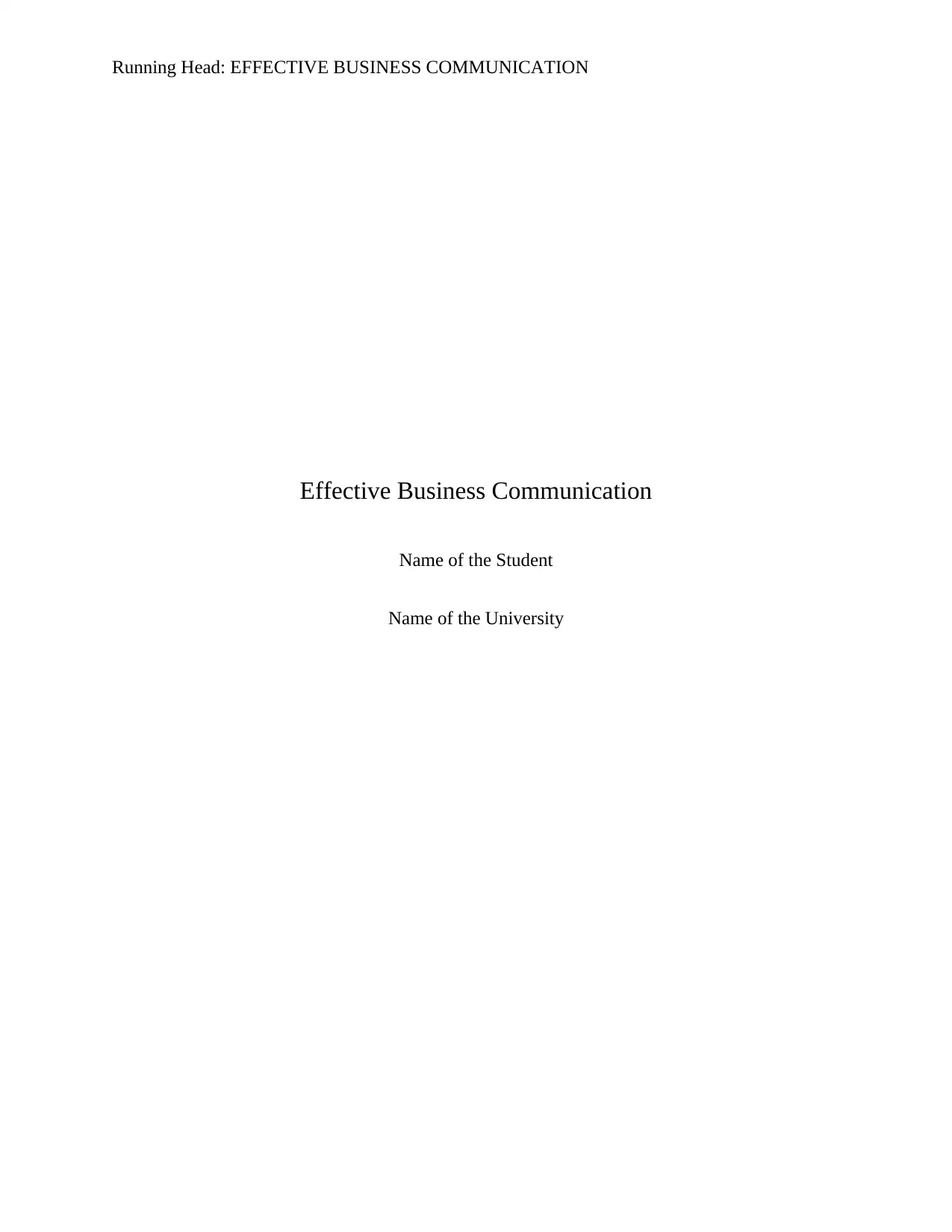
Running Head: EFFECTIVE BUSINESS COMMUNICATION
Effective Business Communication
Name of the Student
Name of the University
Effective Business Communication
Name of the Student
Name of the University
Secure Best Marks with AI Grader
Need help grading? Try our AI Grader for instant feedback on your assignments.
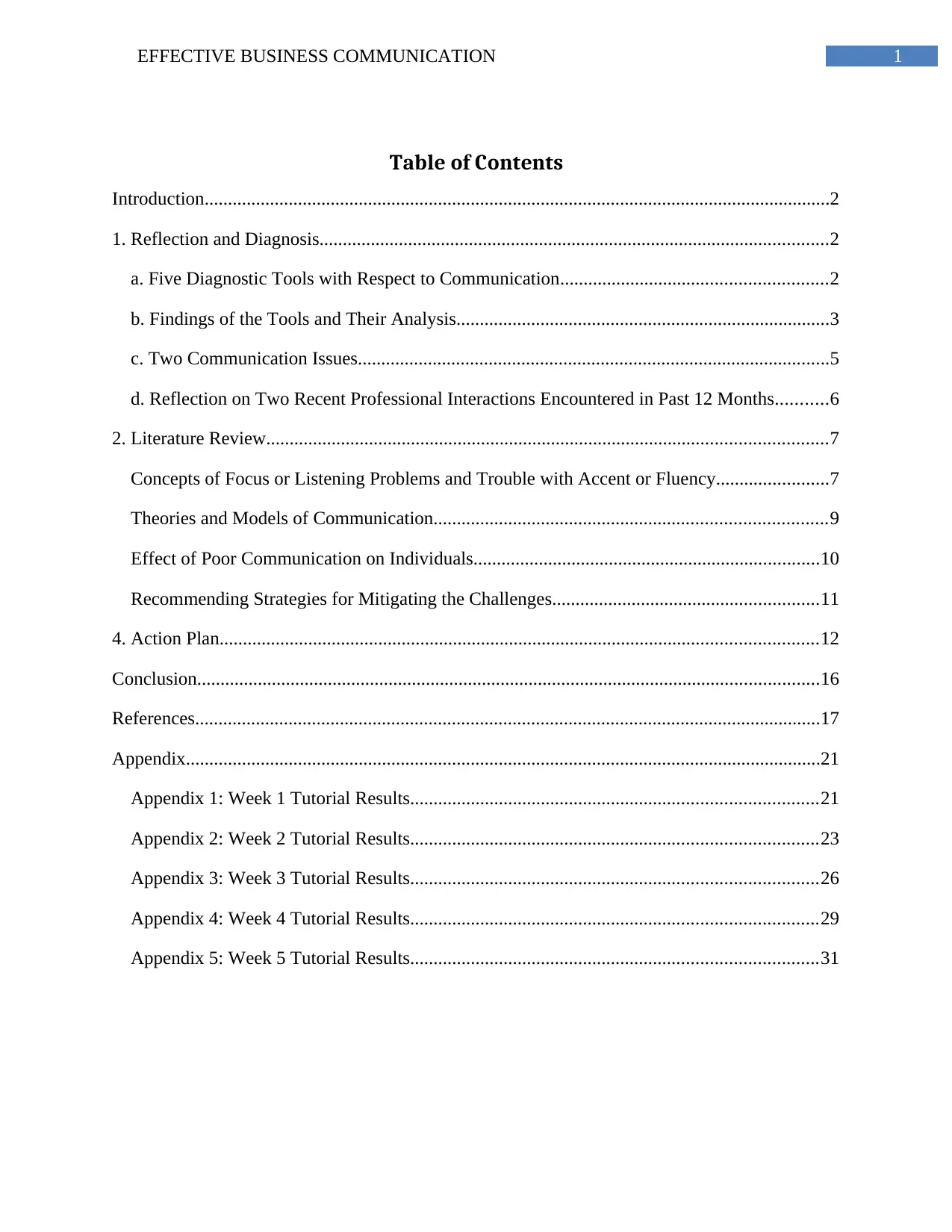
1EFFECTIVE BUSINESS COMMUNICATION
Table of Contents
Introduction......................................................................................................................................2
1. Reflection and Diagnosis.............................................................................................................2
a. Five Diagnostic Tools with Respect to Communication.........................................................2
b. Findings of the Tools and Their Analysis................................................................................3
c. Two Communication Issues.....................................................................................................5
d. Reflection on Two Recent Professional Interactions Encountered in Past 12 Months...........6
2. Literature Review........................................................................................................................7
Concepts of Focus or Listening Problems and Trouble with Accent or Fluency........................7
Theories and Models of Communication....................................................................................9
Effect of Poor Communication on Individuals..........................................................................10
Recommending Strategies for Mitigating the Challenges.........................................................11
4. Action Plan................................................................................................................................12
Conclusion.....................................................................................................................................16
References......................................................................................................................................17
Appendix........................................................................................................................................21
Appendix 1: Week 1 Tutorial Results.......................................................................................21
Appendix 2: Week 2 Tutorial Results.......................................................................................23
Appendix 3: Week 3 Tutorial Results.......................................................................................26
Appendix 4: Week 4 Tutorial Results.......................................................................................29
Appendix 5: Week 5 Tutorial Results.......................................................................................31
Table of Contents
Introduction......................................................................................................................................2
1. Reflection and Diagnosis.............................................................................................................2
a. Five Diagnostic Tools with Respect to Communication.........................................................2
b. Findings of the Tools and Their Analysis................................................................................3
c. Two Communication Issues.....................................................................................................5
d. Reflection on Two Recent Professional Interactions Encountered in Past 12 Months...........6
2. Literature Review........................................................................................................................7
Concepts of Focus or Listening Problems and Trouble with Accent or Fluency........................7
Theories and Models of Communication....................................................................................9
Effect of Poor Communication on Individuals..........................................................................10
Recommending Strategies for Mitigating the Challenges.........................................................11
4. Action Plan................................................................................................................................12
Conclusion.....................................................................................................................................16
References......................................................................................................................................17
Appendix........................................................................................................................................21
Appendix 1: Week 1 Tutorial Results.......................................................................................21
Appendix 2: Week 2 Tutorial Results.......................................................................................23
Appendix 3: Week 3 Tutorial Results.......................................................................................26
Appendix 4: Week 4 Tutorial Results.......................................................................................29
Appendix 5: Week 5 Tutorial Results.......................................................................................31
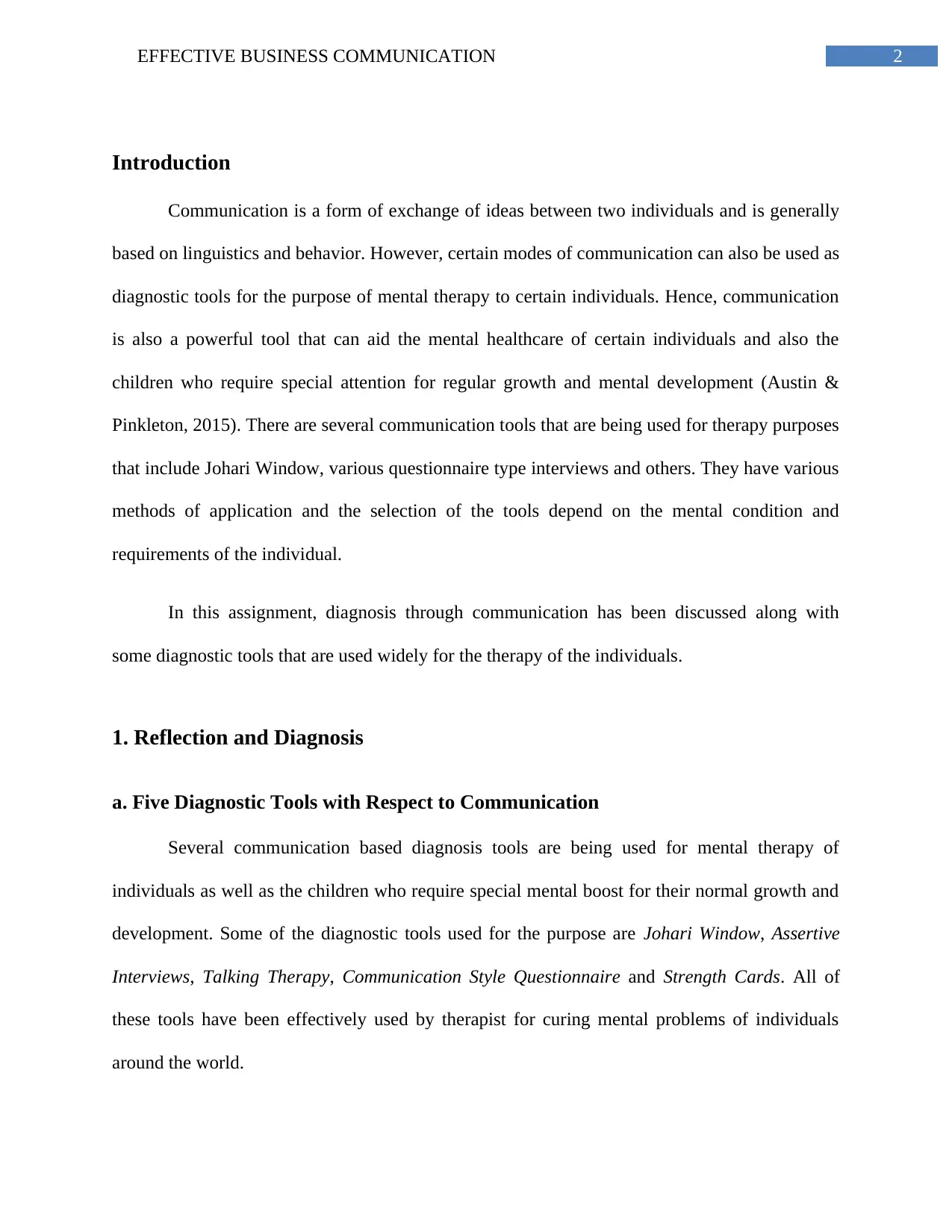
2EFFECTIVE BUSINESS COMMUNICATION
Introduction
Communication is a form of exchange of ideas between two individuals and is generally
based on linguistics and behavior. However, certain modes of communication can also be used as
diagnostic tools for the purpose of mental therapy to certain individuals. Hence, communication
is also a powerful tool that can aid the mental healthcare of certain individuals and also the
children who require special attention for regular growth and mental development (Austin &
Pinkleton, 2015). There are several communication tools that are being used for therapy purposes
that include Johari Window, various questionnaire type interviews and others. They have various
methods of application and the selection of the tools depend on the mental condition and
requirements of the individual.
In this assignment, diagnosis through communication has been discussed along with
some diagnostic tools that are used widely for the therapy of the individuals.
1. Reflection and Diagnosis
a. Five Diagnostic Tools with Respect to Communication
Several communication based diagnosis tools are being used for mental therapy of
individuals as well as the children who require special mental boost for their normal growth and
development. Some of the diagnostic tools used for the purpose are Johari Window, Assertive
Interviews, Talking Therapy, Communication Style Questionnaire and Strength Cards. All of
these tools have been effectively used by therapist for curing mental problems of individuals
around the world.
Introduction
Communication is a form of exchange of ideas between two individuals and is generally
based on linguistics and behavior. However, certain modes of communication can also be used as
diagnostic tools for the purpose of mental therapy to certain individuals. Hence, communication
is also a powerful tool that can aid the mental healthcare of certain individuals and also the
children who require special attention for regular growth and mental development (Austin &
Pinkleton, 2015). There are several communication tools that are being used for therapy purposes
that include Johari Window, various questionnaire type interviews and others. They have various
methods of application and the selection of the tools depend on the mental condition and
requirements of the individual.
In this assignment, diagnosis through communication has been discussed along with
some diagnostic tools that are used widely for the therapy of the individuals.
1. Reflection and Diagnosis
a. Five Diagnostic Tools with Respect to Communication
Several communication based diagnosis tools are being used for mental therapy of
individuals as well as the children who require special mental boost for their normal growth and
development. Some of the diagnostic tools used for the purpose are Johari Window, Assertive
Interviews, Talking Therapy, Communication Style Questionnaire and Strength Cards. All of
these tools have been effectively used by therapist for curing mental problems of individuals
around the world.
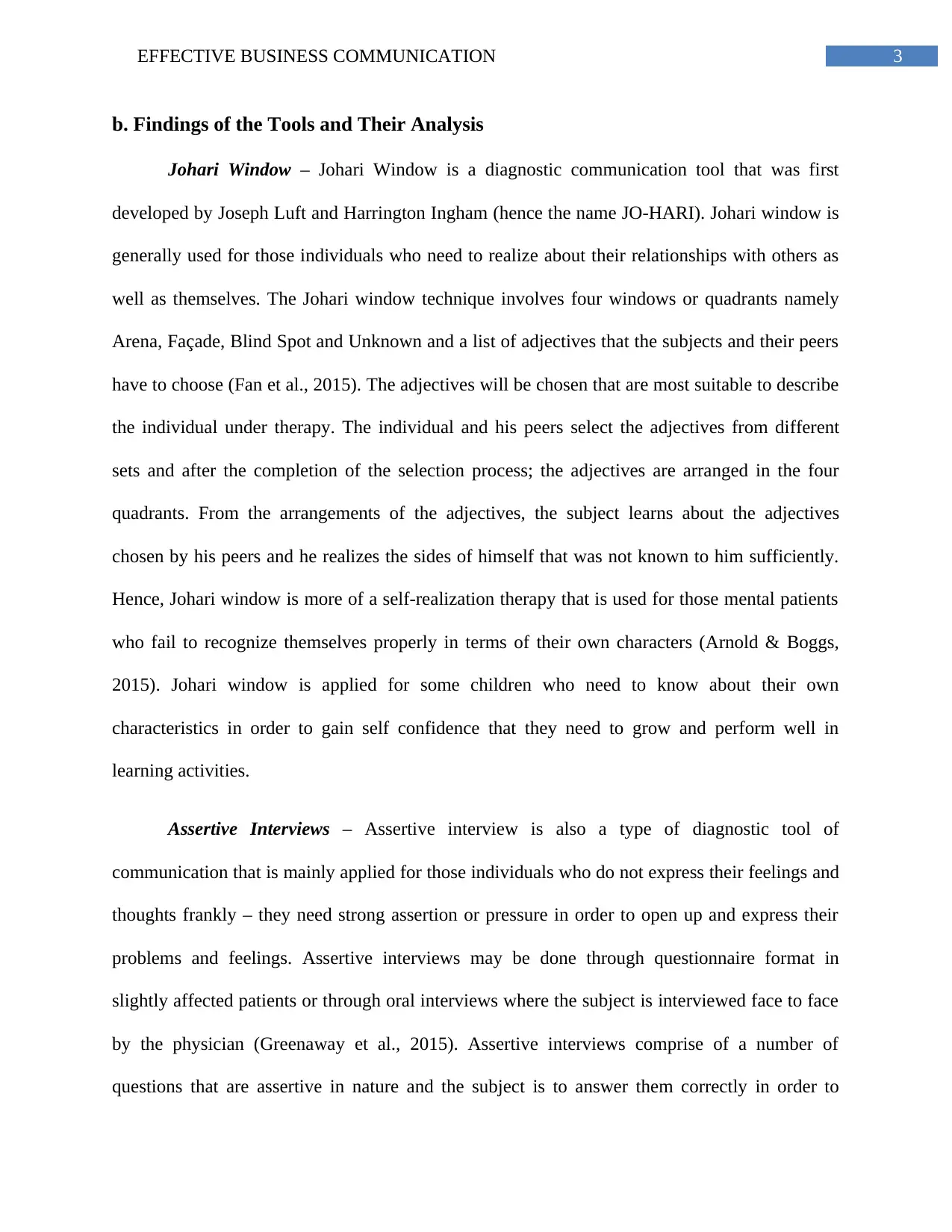
3EFFECTIVE BUSINESS COMMUNICATION
b. Findings of the Tools and Their Analysis
Johari Window – Johari Window is a diagnostic communication tool that was first
developed by Joseph Luft and Harrington Ingham (hence the name JO-HARI). Johari window is
generally used for those individuals who need to realize about their relationships with others as
well as themselves. The Johari window technique involves four windows or quadrants namely
Arena, Façade, Blind Spot and Unknown and a list of adjectives that the subjects and their peers
have to choose (Fan et al., 2015). The adjectives will be chosen that are most suitable to describe
the individual under therapy. The individual and his peers select the adjectives from different
sets and after the completion of the selection process; the adjectives are arranged in the four
quadrants. From the arrangements of the adjectives, the subject learns about the adjectives
chosen by his peers and he realizes the sides of himself that was not known to him sufficiently.
Hence, Johari window is more of a self-realization therapy that is used for those mental patients
who fail to recognize themselves properly in terms of their own characters (Arnold & Boggs,
2015). Johari window is applied for some children who need to know about their own
characteristics in order to gain self confidence that they need to grow and perform well in
learning activities.
Assertive Interviews – Assertive interview is also a type of diagnostic tool of
communication that is mainly applied for those individuals who do not express their feelings and
thoughts frankly – they need strong assertion or pressure in order to open up and express their
problems and feelings. Assertive interviews may be done through questionnaire format in
slightly affected patients or through oral interviews where the subject is interviewed face to face
by the physician (Greenaway et al., 2015). Assertive interviews comprise of a number of
questions that are assertive in nature and the subject is to answer them correctly in order to
b. Findings of the Tools and Their Analysis
Johari Window – Johari Window is a diagnostic communication tool that was first
developed by Joseph Luft and Harrington Ingham (hence the name JO-HARI). Johari window is
generally used for those individuals who need to realize about their relationships with others as
well as themselves. The Johari window technique involves four windows or quadrants namely
Arena, Façade, Blind Spot and Unknown and a list of adjectives that the subjects and their peers
have to choose (Fan et al., 2015). The adjectives will be chosen that are most suitable to describe
the individual under therapy. The individual and his peers select the adjectives from different
sets and after the completion of the selection process; the adjectives are arranged in the four
quadrants. From the arrangements of the adjectives, the subject learns about the adjectives
chosen by his peers and he realizes the sides of himself that was not known to him sufficiently.
Hence, Johari window is more of a self-realization therapy that is used for those mental patients
who fail to recognize themselves properly in terms of their own characters (Arnold & Boggs,
2015). Johari window is applied for some children who need to know about their own
characteristics in order to gain self confidence that they need to grow and perform well in
learning activities.
Assertive Interviews – Assertive interview is also a type of diagnostic tool of
communication that is mainly applied for those individuals who do not express their feelings and
thoughts frankly – they need strong assertion or pressure in order to open up and express their
problems and feelings. Assertive interviews may be done through questionnaire format in
slightly affected patients or through oral interviews where the subject is interviewed face to face
by the physician (Greenaway et al., 2015). Assertive interviews comprise of a number of
questions that are assertive in nature and the subject is to answer them correctly in order to
Secure Best Marks with AI Grader
Need help grading? Try our AI Grader for instant feedback on your assignments.
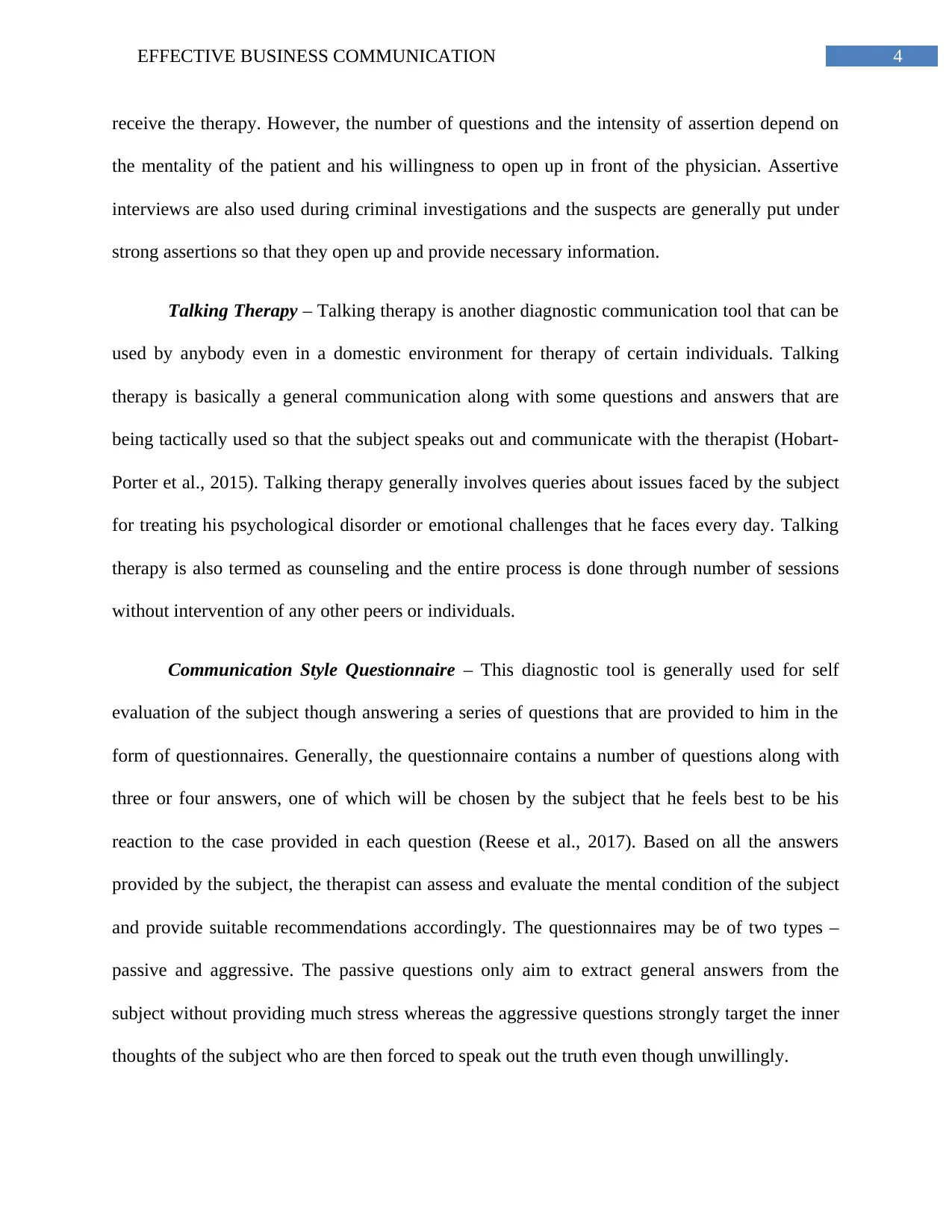
4EFFECTIVE BUSINESS COMMUNICATION
receive the therapy. However, the number of questions and the intensity of assertion depend on
the mentality of the patient and his willingness to open up in front of the physician. Assertive
interviews are also used during criminal investigations and the suspects are generally put under
strong assertions so that they open up and provide necessary information.
Talking Therapy – Talking therapy is another diagnostic communication tool that can be
used by anybody even in a domestic environment for therapy of certain individuals. Talking
therapy is basically a general communication along with some questions and answers that are
being tactically used so that the subject speaks out and communicate with the therapist (Hobart-
Porter et al., 2015). Talking therapy generally involves queries about issues faced by the subject
for treating his psychological disorder or emotional challenges that he faces every day. Talking
therapy is also termed as counseling and the entire process is done through number of sessions
without intervention of any other peers or individuals.
Communication Style Questionnaire – This diagnostic tool is generally used for self
evaluation of the subject though answering a series of questions that are provided to him in the
form of questionnaires. Generally, the questionnaire contains a number of questions along with
three or four answers, one of which will be chosen by the subject that he feels best to be his
reaction to the case provided in each question (Reese et al., 2017). Based on all the answers
provided by the subject, the therapist can assess and evaluate the mental condition of the subject
and provide suitable recommendations accordingly. The questionnaires may be of two types –
passive and aggressive. The passive questions only aim to extract general answers from the
subject without providing much stress whereas the aggressive questions strongly target the inner
thoughts of the subject who are then forced to speak out the truth even though unwillingly.
receive the therapy. However, the number of questions and the intensity of assertion depend on
the mentality of the patient and his willingness to open up in front of the physician. Assertive
interviews are also used during criminal investigations and the suspects are generally put under
strong assertions so that they open up and provide necessary information.
Talking Therapy – Talking therapy is another diagnostic communication tool that can be
used by anybody even in a domestic environment for therapy of certain individuals. Talking
therapy is basically a general communication along with some questions and answers that are
being tactically used so that the subject speaks out and communicate with the therapist (Hobart-
Porter et al., 2015). Talking therapy generally involves queries about issues faced by the subject
for treating his psychological disorder or emotional challenges that he faces every day. Talking
therapy is also termed as counseling and the entire process is done through number of sessions
without intervention of any other peers or individuals.
Communication Style Questionnaire – This diagnostic tool is generally used for self
evaluation of the subject though answering a series of questions that are provided to him in the
form of questionnaires. Generally, the questionnaire contains a number of questions along with
three or four answers, one of which will be chosen by the subject that he feels best to be his
reaction to the case provided in each question (Reese et al., 2017). Based on all the answers
provided by the subject, the therapist can assess and evaluate the mental condition of the subject
and provide suitable recommendations accordingly. The questionnaires may be of two types –
passive and aggressive. The passive questions only aim to extract general answers from the
subject without providing much stress whereas the aggressive questions strongly target the inner
thoughts of the subject who are then forced to speak out the truth even though unwillingly.
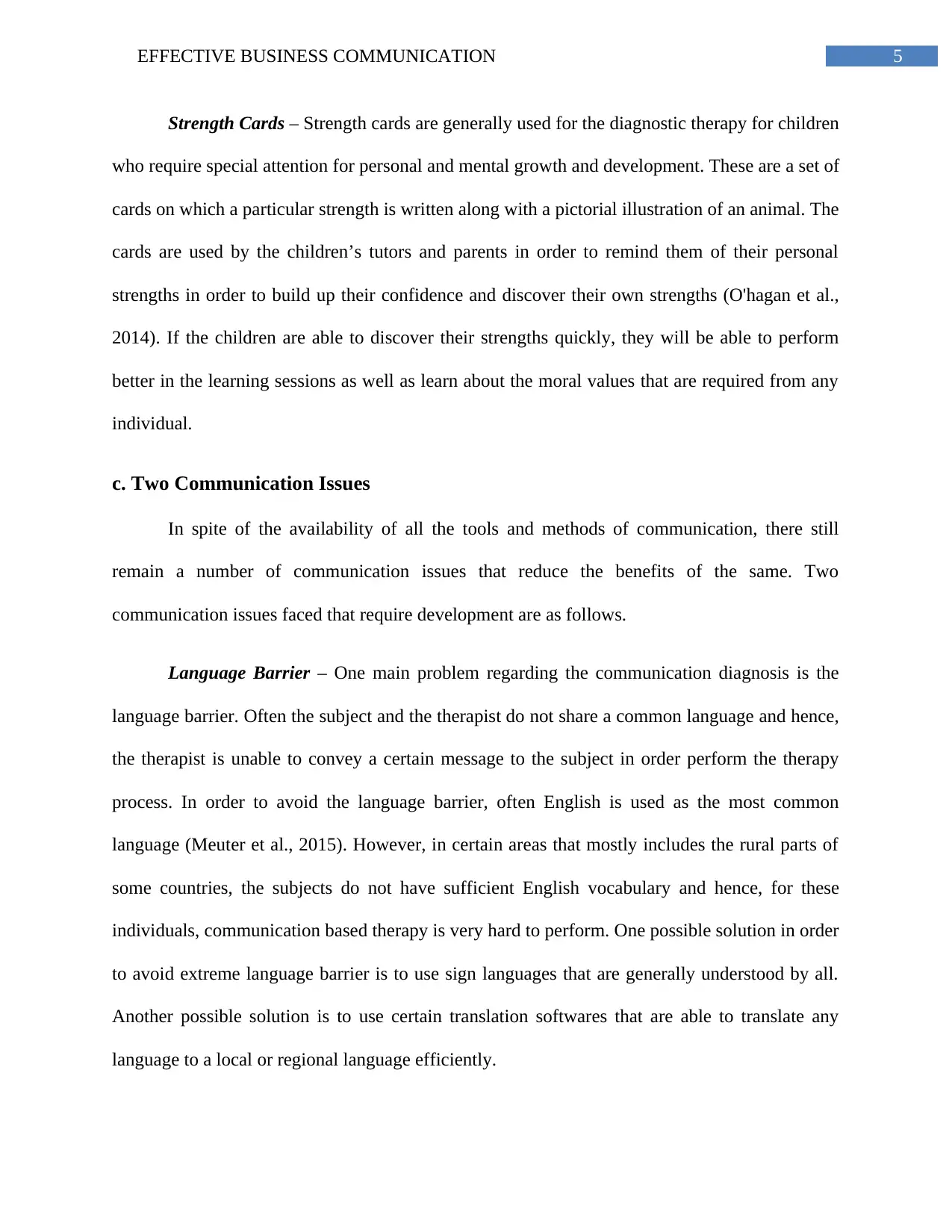
5EFFECTIVE BUSINESS COMMUNICATION
Strength Cards – Strength cards are generally used for the diagnostic therapy for children
who require special attention for personal and mental growth and development. These are a set of
cards on which a particular strength is written along with a pictorial illustration of an animal. The
cards are used by the children’s tutors and parents in order to remind them of their personal
strengths in order to build up their confidence and discover their own strengths (O'hagan et al.,
2014). If the children are able to discover their strengths quickly, they will be able to perform
better in the learning sessions as well as learn about the moral values that are required from any
individual.
c. Two Communication Issues
In spite of the availability of all the tools and methods of communication, there still
remain a number of communication issues that reduce the benefits of the same. Two
communication issues faced that require development are as follows.
Language Barrier – One main problem regarding the communication diagnosis is the
language barrier. Often the subject and the therapist do not share a common language and hence,
the therapist is unable to convey a certain message to the subject in order perform the therapy
process. In order to avoid the language barrier, often English is used as the most common
language (Meuter et al., 2015). However, in certain areas that mostly includes the rural parts of
some countries, the subjects do not have sufficient English vocabulary and hence, for these
individuals, communication based therapy is very hard to perform. One possible solution in order
to avoid extreme language barrier is to use sign languages that are generally understood by all.
Another possible solution is to use certain translation softwares that are able to translate any
language to a local or regional language efficiently.
Strength Cards – Strength cards are generally used for the diagnostic therapy for children
who require special attention for personal and mental growth and development. These are a set of
cards on which a particular strength is written along with a pictorial illustration of an animal. The
cards are used by the children’s tutors and parents in order to remind them of their personal
strengths in order to build up their confidence and discover their own strengths (O'hagan et al.,
2014). If the children are able to discover their strengths quickly, they will be able to perform
better in the learning sessions as well as learn about the moral values that are required from any
individual.
c. Two Communication Issues
In spite of the availability of all the tools and methods of communication, there still
remain a number of communication issues that reduce the benefits of the same. Two
communication issues faced that require development are as follows.
Language Barrier – One main problem regarding the communication diagnosis is the
language barrier. Often the subject and the therapist do not share a common language and hence,
the therapist is unable to convey a certain message to the subject in order perform the therapy
process. In order to avoid the language barrier, often English is used as the most common
language (Meuter et al., 2015). However, in certain areas that mostly includes the rural parts of
some countries, the subjects do not have sufficient English vocabulary and hence, for these
individuals, communication based therapy is very hard to perform. One possible solution in order
to avoid extreme language barrier is to use sign languages that are generally understood by all.
Another possible solution is to use certain translation softwares that are able to translate any
language to a local or regional language efficiently.
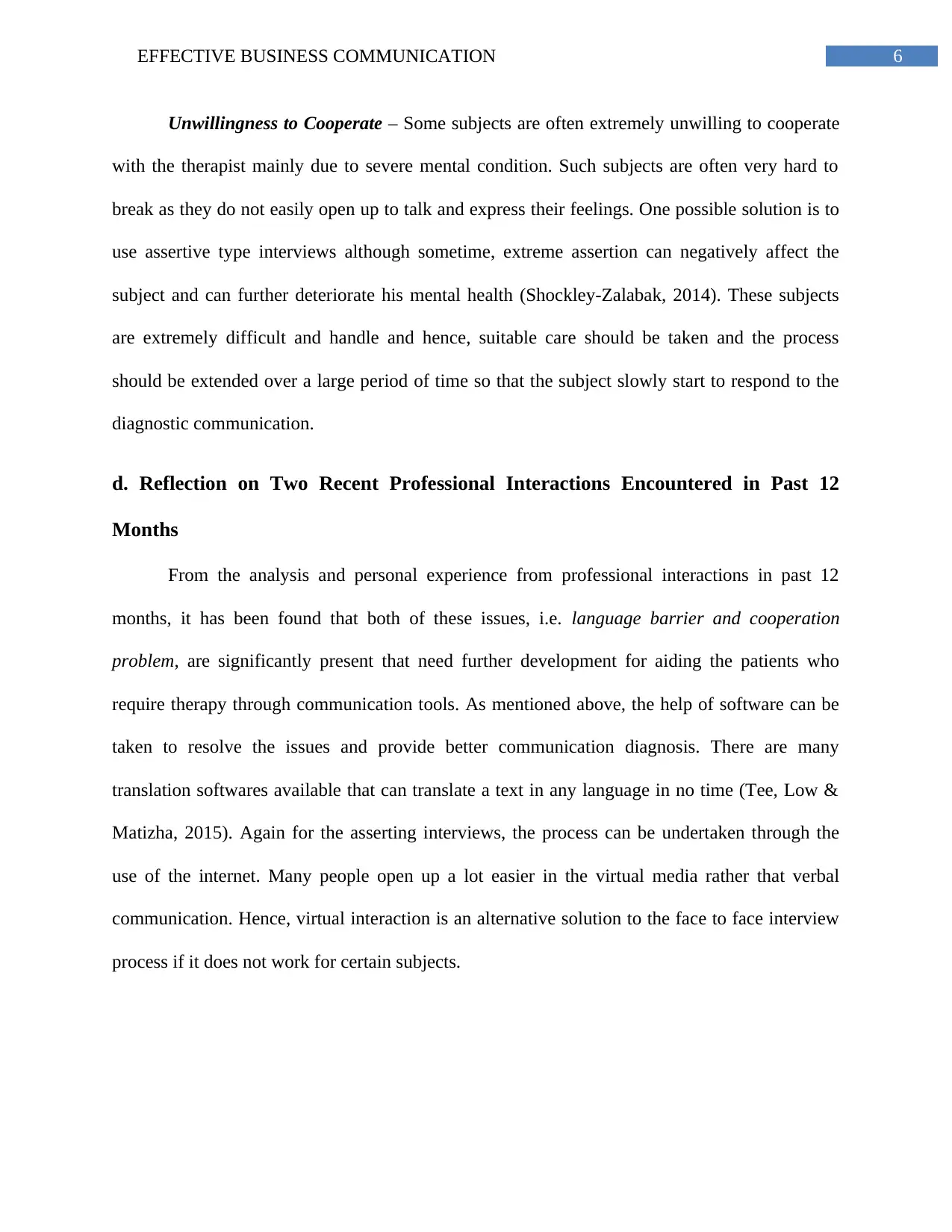
6EFFECTIVE BUSINESS COMMUNICATION
Unwillingness to Cooperate – Some subjects are often extremely unwilling to cooperate
with the therapist mainly due to severe mental condition. Such subjects are often very hard to
break as they do not easily open up to talk and express their feelings. One possible solution is to
use assertive type interviews although sometime, extreme assertion can negatively affect the
subject and can further deteriorate his mental health (Shockley-Zalabak, 2014). These subjects
are extremely difficult and handle and hence, suitable care should be taken and the process
should be extended over a large period of time so that the subject slowly start to respond to the
diagnostic communication.
d. Reflection on Two Recent Professional Interactions Encountered in Past 12
Months
From the analysis and personal experience from professional interactions in past 12
months, it has been found that both of these issues, i.e. language barrier and cooperation
problem, are significantly present that need further development for aiding the patients who
require therapy through communication tools. As mentioned above, the help of software can be
taken to resolve the issues and provide better communication diagnosis. There are many
translation softwares available that can translate a text in any language in no time (Tee, Low &
Matizha, 2015). Again for the asserting interviews, the process can be undertaken through the
use of the internet. Many people open up a lot easier in the virtual media rather that verbal
communication. Hence, virtual interaction is an alternative solution to the face to face interview
process if it does not work for certain subjects.
Unwillingness to Cooperate – Some subjects are often extremely unwilling to cooperate
with the therapist mainly due to severe mental condition. Such subjects are often very hard to
break as they do not easily open up to talk and express their feelings. One possible solution is to
use assertive type interviews although sometime, extreme assertion can negatively affect the
subject and can further deteriorate his mental health (Shockley-Zalabak, 2014). These subjects
are extremely difficult and handle and hence, suitable care should be taken and the process
should be extended over a large period of time so that the subject slowly start to respond to the
diagnostic communication.
d. Reflection on Two Recent Professional Interactions Encountered in Past 12
Months
From the analysis and personal experience from professional interactions in past 12
months, it has been found that both of these issues, i.e. language barrier and cooperation
problem, are significantly present that need further development for aiding the patients who
require therapy through communication tools. As mentioned above, the help of software can be
taken to resolve the issues and provide better communication diagnosis. There are many
translation softwares available that can translate a text in any language in no time (Tee, Low &
Matizha, 2015). Again for the asserting interviews, the process can be undertaken through the
use of the internet. Many people open up a lot easier in the virtual media rather that verbal
communication. Hence, virtual interaction is an alternative solution to the face to face interview
process if it does not work for certain subjects.
Paraphrase This Document
Need a fresh take? Get an instant paraphrase of this document with our AI Paraphraser
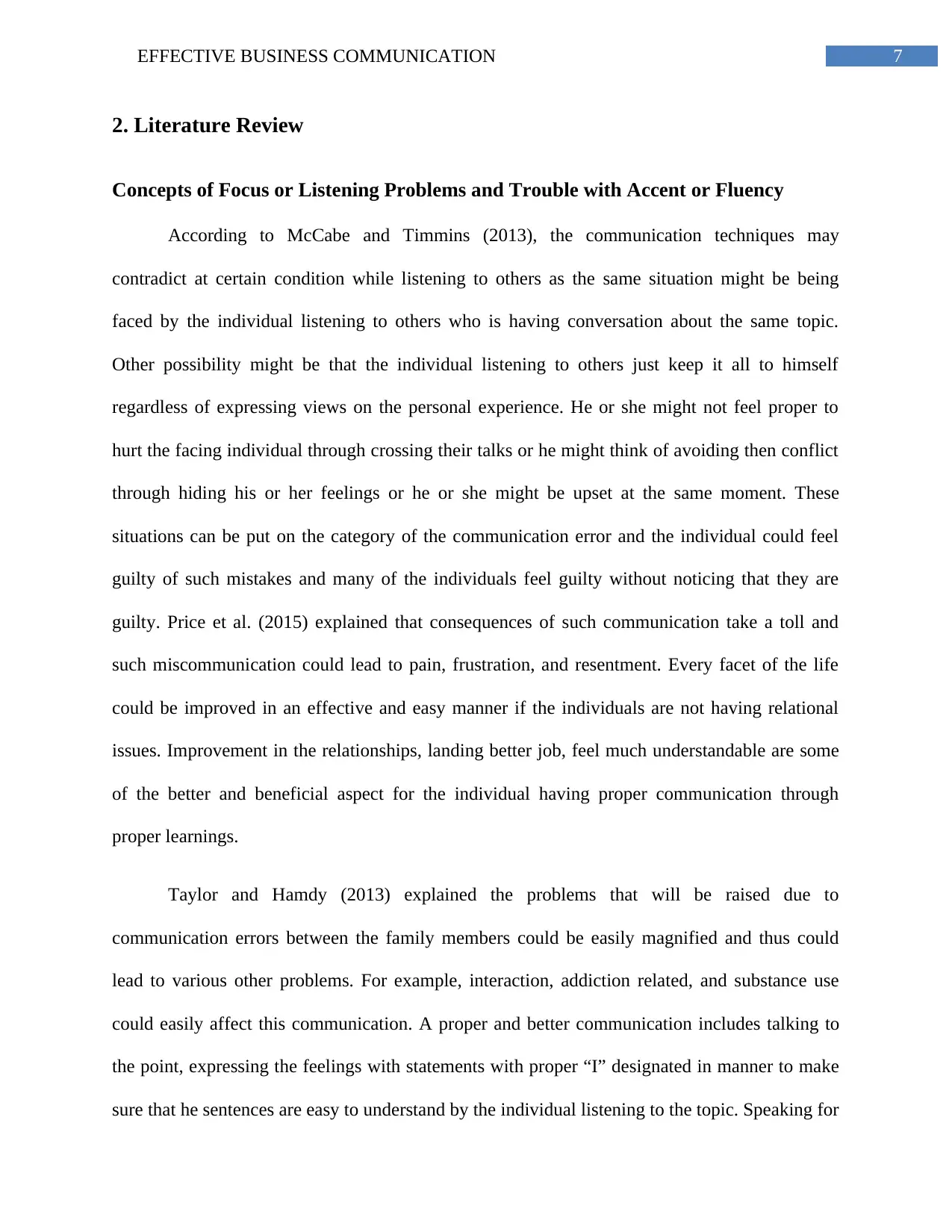
7EFFECTIVE BUSINESS COMMUNICATION
2. Literature Review
Concepts of Focus or Listening Problems and Trouble with Accent or Fluency
According to McCabe and Timmins (2013), the communication techniques may
contradict at certain condition while listening to others as the same situation might be being
faced by the individual listening to others who is having conversation about the same topic.
Other possibility might be that the individual listening to others just keep it all to himself
regardless of expressing views on the personal experience. He or she might not feel proper to
hurt the facing individual through crossing their talks or he might think of avoiding then conflict
through hiding his or her feelings or he or she might be upset at the same moment. These
situations can be put on the category of the communication error and the individual could feel
guilty of such mistakes and many of the individuals feel guilty without noticing that they are
guilty. Price et al. (2015) explained that consequences of such communication take a toll and
such miscommunication could lead to pain, frustration, and resentment. Every facet of the life
could be improved in an effective and easy manner if the individuals are not having relational
issues. Improvement in the relationships, landing better job, feel much understandable are some
of the better and beneficial aspect for the individual having proper communication through
proper learnings.
Taylor and Hamdy (2013) explained the problems that will be raised due to
communication errors between the family members could be easily magnified and thus could
lead to various other problems. For example, interaction, addiction related, and substance use
could easily affect this communication. A proper and better communication includes talking to
the point, expressing the feelings with statements with proper “I” designated in manner to make
sure that he sentences are easy to understand by the individual listening to the topic. Speaking for
2. Literature Review
Concepts of Focus or Listening Problems and Trouble with Accent or Fluency
According to McCabe and Timmins (2013), the communication techniques may
contradict at certain condition while listening to others as the same situation might be being
faced by the individual listening to others who is having conversation about the same topic.
Other possibility might be that the individual listening to others just keep it all to himself
regardless of expressing views on the personal experience. He or she might not feel proper to
hurt the facing individual through crossing their talks or he might think of avoiding then conflict
through hiding his or her feelings or he or she might be upset at the same moment. These
situations can be put on the category of the communication error and the individual could feel
guilty of such mistakes and many of the individuals feel guilty without noticing that they are
guilty. Price et al. (2015) explained that consequences of such communication take a toll and
such miscommunication could lead to pain, frustration, and resentment. Every facet of the life
could be improved in an effective and easy manner if the individuals are not having relational
issues. Improvement in the relationships, landing better job, feel much understandable are some
of the better and beneficial aspect for the individual having proper communication through
proper learnings.
Taylor and Hamdy (2013) explained the problems that will be raised due to
communication errors between the family members could be easily magnified and thus could
lead to various other problems. For example, interaction, addiction related, and substance use
could easily affect this communication. A proper and better communication includes talking to
the point, expressing the feelings with statements with proper “I” designated in manner to make
sure that he sentences are easy to understand by the individual listening to the topic. Speaking for
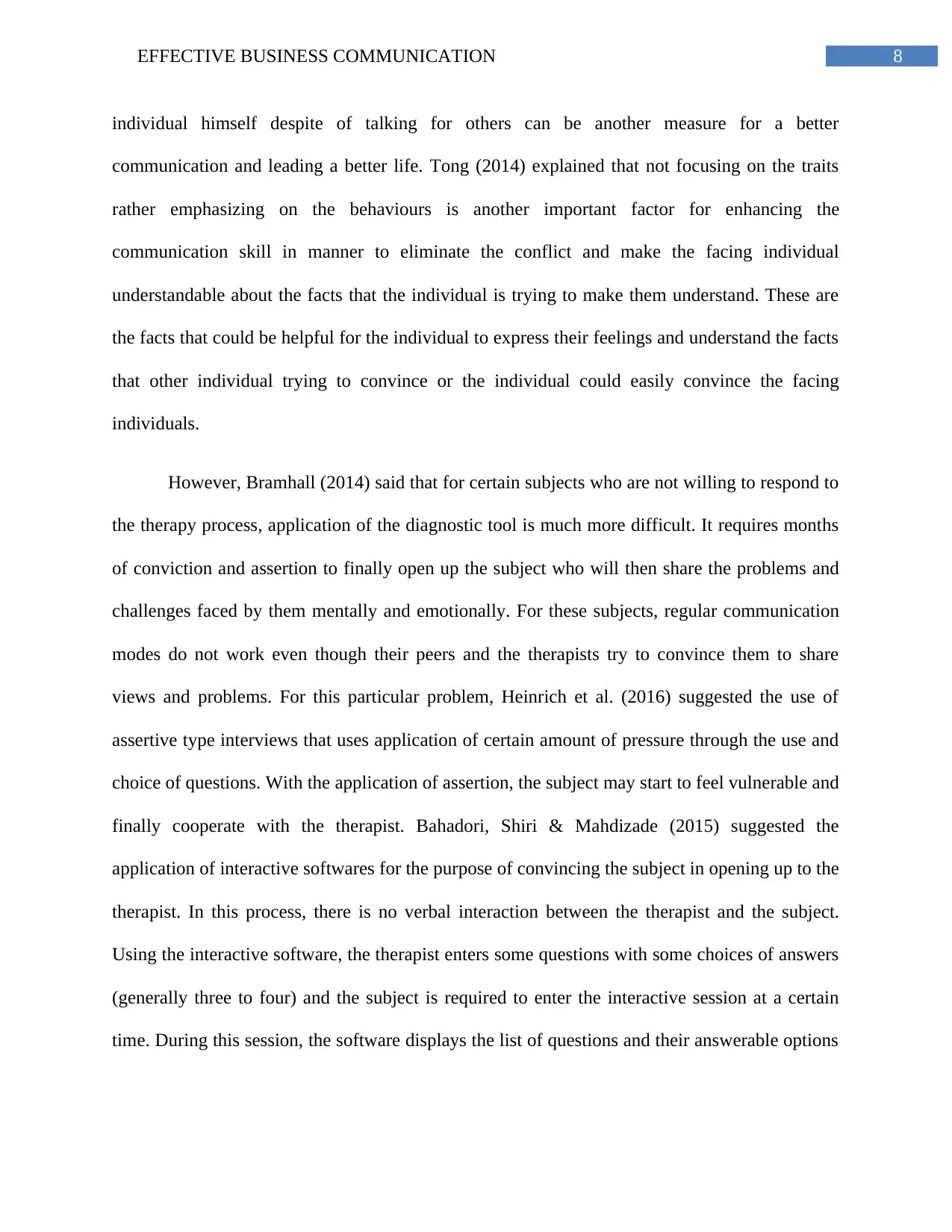
8EFFECTIVE BUSINESS COMMUNICATION
individual himself despite of talking for others can be another measure for a better
communication and leading a better life. Tong (2014) explained that not focusing on the traits
rather emphasizing on the behaviours is another important factor for enhancing the
communication skill in manner to eliminate the conflict and make the facing individual
understandable about the facts that the individual is trying to make them understand. These are
the facts that could be helpful for the individual to express their feelings and understand the facts
that other individual trying to convince or the individual could easily convince the facing
individuals.
However, Bramhall (2014) said that for certain subjects who are not willing to respond to
the therapy process, application of the diagnostic tool is much more difficult. It requires months
of conviction and assertion to finally open up the subject who will then share the problems and
challenges faced by them mentally and emotionally. For these subjects, regular communication
modes do not work even though their peers and the therapists try to convince them to share
views and problems. For this particular problem, Heinrich et al. (2016) suggested the use of
assertive type interviews that uses application of certain amount of pressure through the use and
choice of questions. With the application of assertion, the subject may start to feel vulnerable and
finally cooperate with the therapist. Bahadori, Shiri & Mahdizade (2015) suggested the
application of interactive softwares for the purpose of convincing the subject in opening up to the
therapist. In this process, there is no verbal interaction between the therapist and the subject.
Using the interactive software, the therapist enters some questions with some choices of answers
(generally three to four) and the subject is required to enter the interactive session at a certain
time. During this session, the software displays the list of questions and their answerable options
individual himself despite of talking for others can be another measure for a better
communication and leading a better life. Tong (2014) explained that not focusing on the traits
rather emphasizing on the behaviours is another important factor for enhancing the
communication skill in manner to eliminate the conflict and make the facing individual
understandable about the facts that the individual is trying to make them understand. These are
the facts that could be helpful for the individual to express their feelings and understand the facts
that other individual trying to convince or the individual could easily convince the facing
individuals.
However, Bramhall (2014) said that for certain subjects who are not willing to respond to
the therapy process, application of the diagnostic tool is much more difficult. It requires months
of conviction and assertion to finally open up the subject who will then share the problems and
challenges faced by them mentally and emotionally. For these subjects, regular communication
modes do not work even though their peers and the therapists try to convince them to share
views and problems. For this particular problem, Heinrich et al. (2016) suggested the use of
assertive type interviews that uses application of certain amount of pressure through the use and
choice of questions. With the application of assertion, the subject may start to feel vulnerable and
finally cooperate with the therapist. Bahadori, Shiri & Mahdizade (2015) suggested the
application of interactive softwares for the purpose of convincing the subject in opening up to the
therapist. In this process, there is no verbal interaction between the therapist and the subject.
Using the interactive software, the therapist enters some questions with some choices of answers
(generally three to four) and the subject is required to enter the interactive session at a certain
time. During this session, the software displays the list of questions and their answerable options
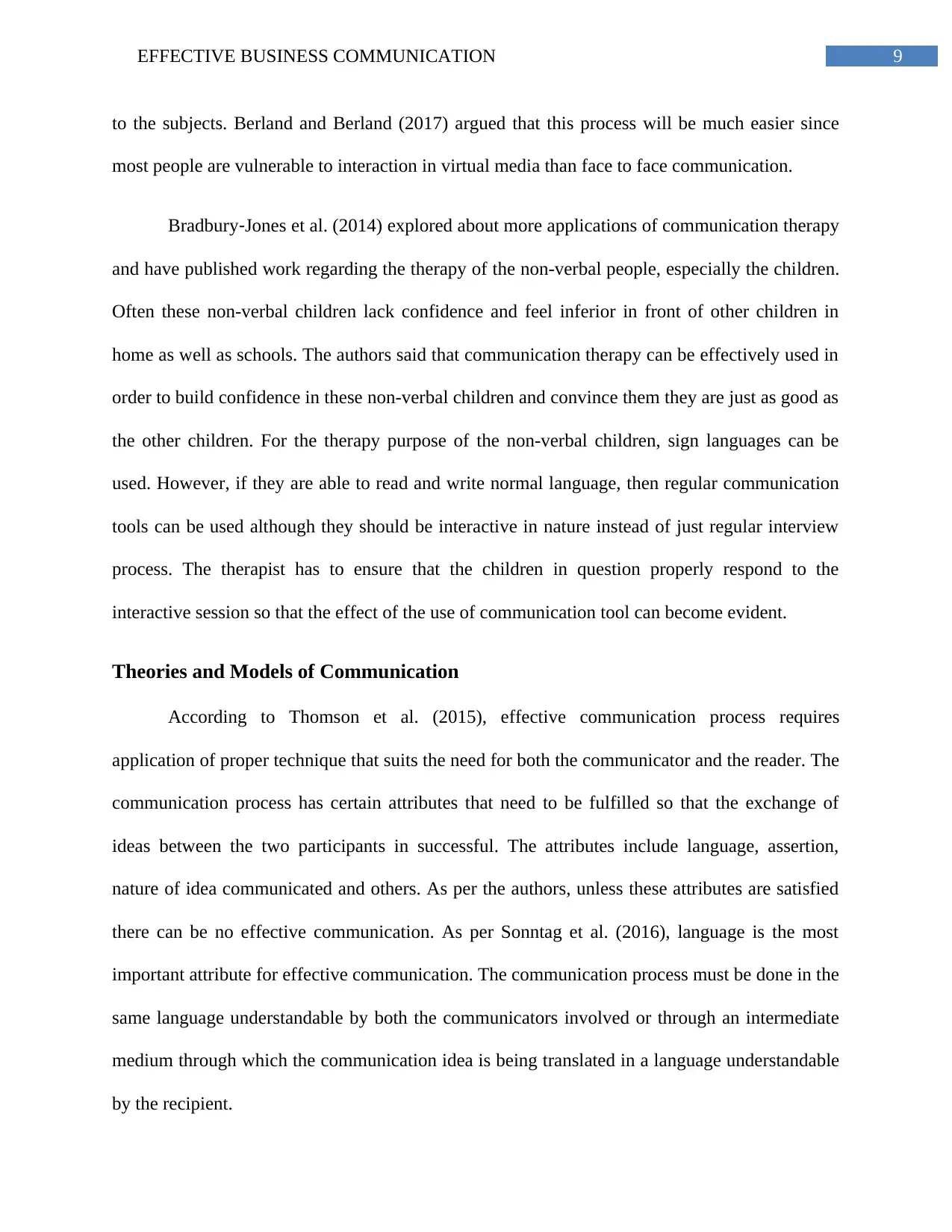
9EFFECTIVE BUSINESS COMMUNICATION
to the subjects. Berland and Berland (2017) argued that this process will be much easier since
most people are vulnerable to interaction in virtual media than face to face communication.
Bradbury‐Jones et al. (2014) explored about more applications of communication therapy
and have published work regarding the therapy of the non-verbal people, especially the children.
Often these non-verbal children lack confidence and feel inferior in front of other children in
home as well as schools. The authors said that communication therapy can be effectively used in
order to build confidence in these non-verbal children and convince them they are just as good as
the other children. For the therapy purpose of the non-verbal children, sign languages can be
used. However, if they are able to read and write normal language, then regular communication
tools can be used although they should be interactive in nature instead of just regular interview
process. The therapist has to ensure that the children in question properly respond to the
interactive session so that the effect of the use of communication tool can become evident.
Theories and Models of Communication
According to Thomson et al. (2015), effective communication process requires
application of proper technique that suits the need for both the communicator and the reader. The
communication process has certain attributes that need to be fulfilled so that the exchange of
ideas between the two participants in successful. The attributes include language, assertion,
nature of idea communicated and others. As per the authors, unless these attributes are satisfied
there can be no effective communication. As per Sonntag et al. (2016), language is the most
important attribute for effective communication. The communication process must be done in the
same language understandable by both the communicators involved or through an intermediate
medium through which the communication idea is being translated in a language understandable
by the recipient.
to the subjects. Berland and Berland (2017) argued that this process will be much easier since
most people are vulnerable to interaction in virtual media than face to face communication.
Bradbury‐Jones et al. (2014) explored about more applications of communication therapy
and have published work regarding the therapy of the non-verbal people, especially the children.
Often these non-verbal children lack confidence and feel inferior in front of other children in
home as well as schools. The authors said that communication therapy can be effectively used in
order to build confidence in these non-verbal children and convince them they are just as good as
the other children. For the therapy purpose of the non-verbal children, sign languages can be
used. However, if they are able to read and write normal language, then regular communication
tools can be used although they should be interactive in nature instead of just regular interview
process. The therapist has to ensure that the children in question properly respond to the
interactive session so that the effect of the use of communication tool can become evident.
Theories and Models of Communication
According to Thomson et al. (2015), effective communication process requires
application of proper technique that suits the need for both the communicator and the reader. The
communication process has certain attributes that need to be fulfilled so that the exchange of
ideas between the two participants in successful. The attributes include language, assertion,
nature of idea communicated and others. As per the authors, unless these attributes are satisfied
there can be no effective communication. As per Sonntag et al. (2016), language is the most
important attribute for effective communication. The communication process must be done in the
same language understandable by both the communicators involved or through an intermediate
medium through which the communication idea is being translated in a language understandable
by the recipient.
Secure Best Marks with AI Grader
Need help grading? Try our AI Grader for instant feedback on your assignments.

10EFFECTIVE BUSINESS COMMUNICATION
According to the works of Delerue & Sicotte (2017), effective communication can
produce a large number of benefits in addition to just exchange of ideas. The primary
requirement for communication is to send an idea from one person to another but the mode of
communication and the choice of words can do a great deal of benefit or damage to a particular
individual. Hence, proper communication process can be used as a mode of therapy for those
subjects who require special attention and care. Communication can also be effectively used to
aid the learning processes of the children so that they understand the ideas well and grow and
develop naturally. As per Drake & Ring (2016), communication is now widely used as a
diagnostic tool for various counseling procedures where subjects participate in order to gain
advice regarding solution to their mental problems.
Effect of Poor Communication on Individuals
A healthy balance between the aggressive communication and passive communication
could be referred through the assertiveness as the individual needs to understand his or her needs
and must advocate them to meet the needs. Compromise can be defined when the individual
listens to other, acknowledge their statements and respect the feelings and statements of other
individual expressing his or her feelings (Tran, 2016). A single statement or sentence can be
expressed in three different forms including aggressive, passive, and assertive and this could be
happened through using different tone. Basic thought, Body language, Language style, and
consequences are some of the situations that an individual need to express in his or her life span.
These thoughts and statements could be delivered in all the mentioned style if any of the
situation is expressed in different style. Better practices and learnings about such techniques and
objectives could be an effective measure for the individual to communicate and express his or
her feelings in the real world.
According to the works of Delerue & Sicotte (2017), effective communication can
produce a large number of benefits in addition to just exchange of ideas. The primary
requirement for communication is to send an idea from one person to another but the mode of
communication and the choice of words can do a great deal of benefit or damage to a particular
individual. Hence, proper communication process can be used as a mode of therapy for those
subjects who require special attention and care. Communication can also be effectively used to
aid the learning processes of the children so that they understand the ideas well and grow and
develop naturally. As per Drake & Ring (2016), communication is now widely used as a
diagnostic tool for various counseling procedures where subjects participate in order to gain
advice regarding solution to their mental problems.
Effect of Poor Communication on Individuals
A healthy balance between the aggressive communication and passive communication
could be referred through the assertiveness as the individual needs to understand his or her needs
and must advocate them to meet the needs. Compromise can be defined when the individual
listens to other, acknowledge their statements and respect the feelings and statements of other
individual expressing his or her feelings (Tran, 2016). A single statement or sentence can be
expressed in three different forms including aggressive, passive, and assertive and this could be
happened through using different tone. Basic thought, Body language, Language style, and
consequences are some of the situations that an individual need to express in his or her life span.
These thoughts and statements could be delivered in all the mentioned style if any of the
situation is expressed in different style. Better practices and learnings about such techniques and
objectives could be an effective measure for the individual to communicate and express his or
her feelings in the real world.

11EFFECTIVE BUSINESS COMMUNICATION
Saxena (2015) provided some of the effective techniques of the communication that
could be helpful for the individuals to communicate and express their feelings in the real world
as such problems could lead to many stresses and other problems. Within a family, it is important
to have an effective communication between the family members and it could act as “preventive
maintenance, reassuring family members that they care about each other and appreciate each
other's efforts.” Good everyday communication could be helpful in making it easier to bring up
requests whenever needed, bring up the issues those could lead to conflict, and resolve those
issues related to the conflicts. Co-occurring disorders could affect the communication between
the family members in many ways such as it could take extra and additional efforts for the
individuals to aware every individual to play their role in the respective sector. There are many
situations in which an individual within the family might feel resist to talk while feeling
depressed or might feel angry or irritable while having a discussion on any topic.
Recommending Strategies for Mitigating the Challenges
Dolan (2017) in their works stated that communication therapy is easier to apply when
the subject cooperates with the therapist and willingly seeks the help of communication therapy.
For this purpose, there are several communication techniques available including Johari window,
assertive interviews and others that aim to help the subjects in rediscovering their own characters
and gain confidence to overcome mental problems. Some of the diagnostic tools have also been
effectively applied on subjects who are under drug abuse or emotional problems. On the other
hand, diagnostic tools like strength cards are effectively used by various kindergarten and lower
schools for the personal development of the children.
Ghaferi & Dimick (2015) said that choice and selection of the communication tool is
necessary in order to aid the therapy of the subject. The authors have raised concern that in many
Saxena (2015) provided some of the effective techniques of the communication that
could be helpful for the individuals to communicate and express their feelings in the real world
as such problems could lead to many stresses and other problems. Within a family, it is important
to have an effective communication between the family members and it could act as “preventive
maintenance, reassuring family members that they care about each other and appreciate each
other's efforts.” Good everyday communication could be helpful in making it easier to bring up
requests whenever needed, bring up the issues those could lead to conflict, and resolve those
issues related to the conflicts. Co-occurring disorders could affect the communication between
the family members in many ways such as it could take extra and additional efforts for the
individuals to aware every individual to play their role in the respective sector. There are many
situations in which an individual within the family might feel resist to talk while feeling
depressed or might feel angry or irritable while having a discussion on any topic.
Recommending Strategies for Mitigating the Challenges
Dolan (2017) in their works stated that communication therapy is easier to apply when
the subject cooperates with the therapist and willingly seeks the help of communication therapy.
For this purpose, there are several communication techniques available including Johari window,
assertive interviews and others that aim to help the subjects in rediscovering their own characters
and gain confidence to overcome mental problems. Some of the diagnostic tools have also been
effectively applied on subjects who are under drug abuse or emotional problems. On the other
hand, diagnostic tools like strength cards are effectively used by various kindergarten and lower
schools for the personal development of the children.
Ghaferi & Dimick (2015) said that choice and selection of the communication tool is
necessary in order to aid the therapy of the subject. The authors have raised concern that in many
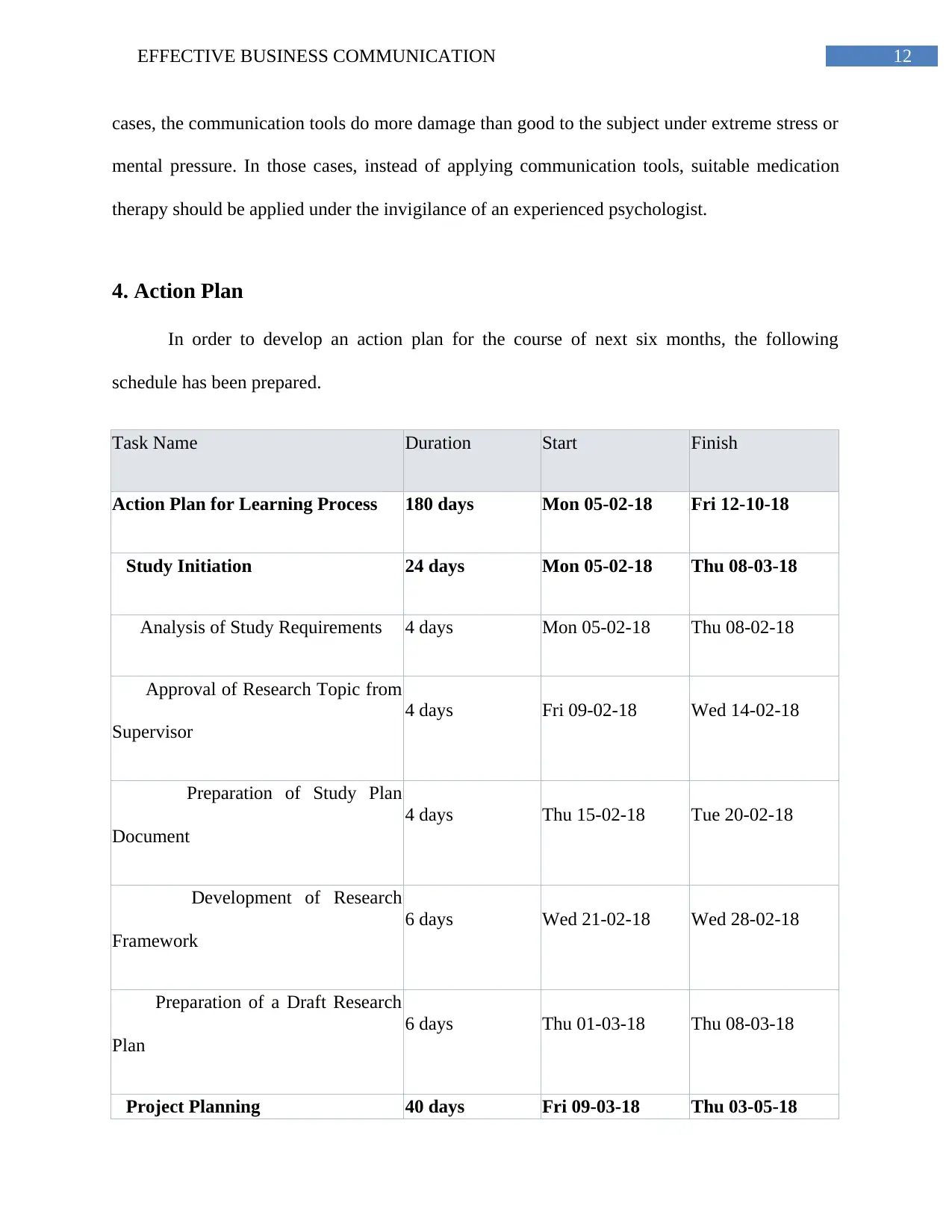
12EFFECTIVE BUSINESS COMMUNICATION
cases, the communication tools do more damage than good to the subject under extreme stress or
mental pressure. In those cases, instead of applying communication tools, suitable medication
therapy should be applied under the invigilance of an experienced psychologist.
4. Action Plan
In order to develop an action plan for the course of next six months, the following
schedule has been prepared.
Task Name Duration Start Finish
Action Plan for Learning Process 180 days Mon 05-02-18 Fri 12-10-18
Study Initiation 24 days Mon 05-02-18 Thu 08-03-18
Analysis of Study Requirements 4 days Mon 05-02-18 Thu 08-02-18
Approval of Research Topic from
Supervisor
4 days Fri 09-02-18 Wed 14-02-18
Preparation of Study Plan
Document
4 days Thu 15-02-18 Tue 20-02-18
Development of Research
Framework
6 days Wed 21-02-18 Wed 28-02-18
Preparation of a Draft Research
Plan
6 days Thu 01-03-18 Thu 08-03-18
Project Planning 40 days Fri 09-03-18 Thu 03-05-18
cases, the communication tools do more damage than good to the subject under extreme stress or
mental pressure. In those cases, instead of applying communication tools, suitable medication
therapy should be applied under the invigilance of an experienced psychologist.
4. Action Plan
In order to develop an action plan for the course of next six months, the following
schedule has been prepared.
Task Name Duration Start Finish
Action Plan for Learning Process 180 days Mon 05-02-18 Fri 12-10-18
Study Initiation 24 days Mon 05-02-18 Thu 08-03-18
Analysis of Study Requirements 4 days Mon 05-02-18 Thu 08-02-18
Approval of Research Topic from
Supervisor
4 days Fri 09-02-18 Wed 14-02-18
Preparation of Study Plan
Document
4 days Thu 15-02-18 Tue 20-02-18
Development of Research
Framework
6 days Wed 21-02-18 Wed 28-02-18
Preparation of a Draft Research
Plan
6 days Thu 01-03-18 Thu 08-03-18
Project Planning 40 days Fri 09-03-18 Thu 03-05-18
Paraphrase This Document
Need a fresh take? Get an instant paraphrase of this document with our AI Paraphraser
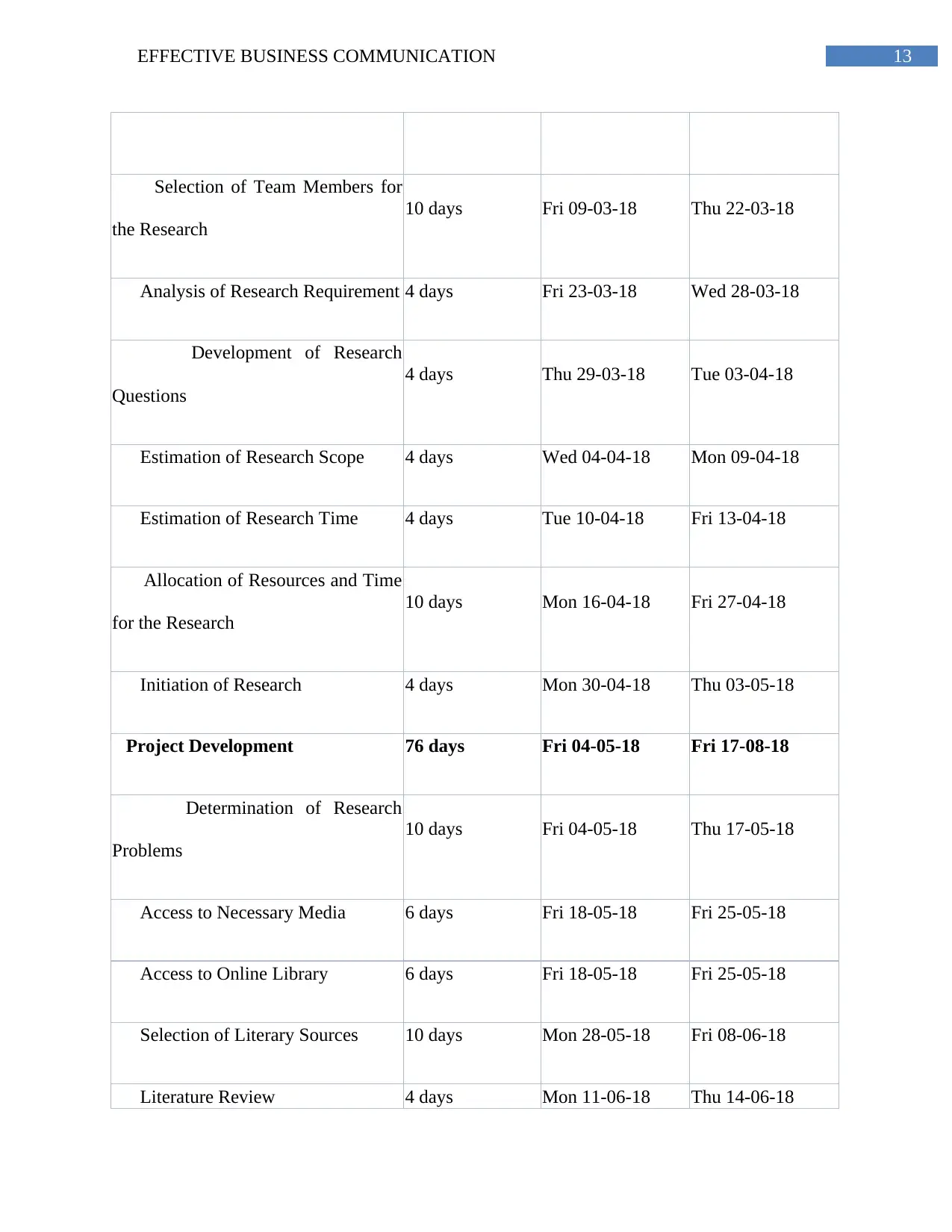
13EFFECTIVE BUSINESS COMMUNICATION
Selection of Team Members for
the Research
10 days Fri 09-03-18 Thu 22-03-18
Analysis of Research Requirement 4 days Fri 23-03-18 Wed 28-03-18
Development of Research
Questions
4 days Thu 29-03-18 Tue 03-04-18
Estimation of Research Scope 4 days Wed 04-04-18 Mon 09-04-18
Estimation of Research Time 4 days Tue 10-04-18 Fri 13-04-18
Allocation of Resources and Time
for the Research
10 days Mon 16-04-18 Fri 27-04-18
Initiation of Research 4 days Mon 30-04-18 Thu 03-05-18
Project Development 76 days Fri 04-05-18 Fri 17-08-18
Determination of Research
Problems
10 days Fri 04-05-18 Thu 17-05-18
Access to Necessary Media 6 days Fri 18-05-18 Fri 25-05-18
Access to Online Library 6 days Fri 18-05-18 Fri 25-05-18
Selection of Literary Sources 10 days Mon 28-05-18 Fri 08-06-18
Literature Review 4 days Mon 11-06-18 Thu 14-06-18
Selection of Team Members for
the Research
10 days Fri 09-03-18 Thu 22-03-18
Analysis of Research Requirement 4 days Fri 23-03-18 Wed 28-03-18
Development of Research
Questions
4 days Thu 29-03-18 Tue 03-04-18
Estimation of Research Scope 4 days Wed 04-04-18 Mon 09-04-18
Estimation of Research Time 4 days Tue 10-04-18 Fri 13-04-18
Allocation of Resources and Time
for the Research
10 days Mon 16-04-18 Fri 27-04-18
Initiation of Research 4 days Mon 30-04-18 Thu 03-05-18
Project Development 76 days Fri 04-05-18 Fri 17-08-18
Determination of Research
Problems
10 days Fri 04-05-18 Thu 17-05-18
Access to Necessary Media 6 days Fri 18-05-18 Fri 25-05-18
Access to Online Library 6 days Fri 18-05-18 Fri 25-05-18
Selection of Literary Sources 10 days Mon 28-05-18 Fri 08-06-18
Literature Review 4 days Mon 11-06-18 Thu 14-06-18
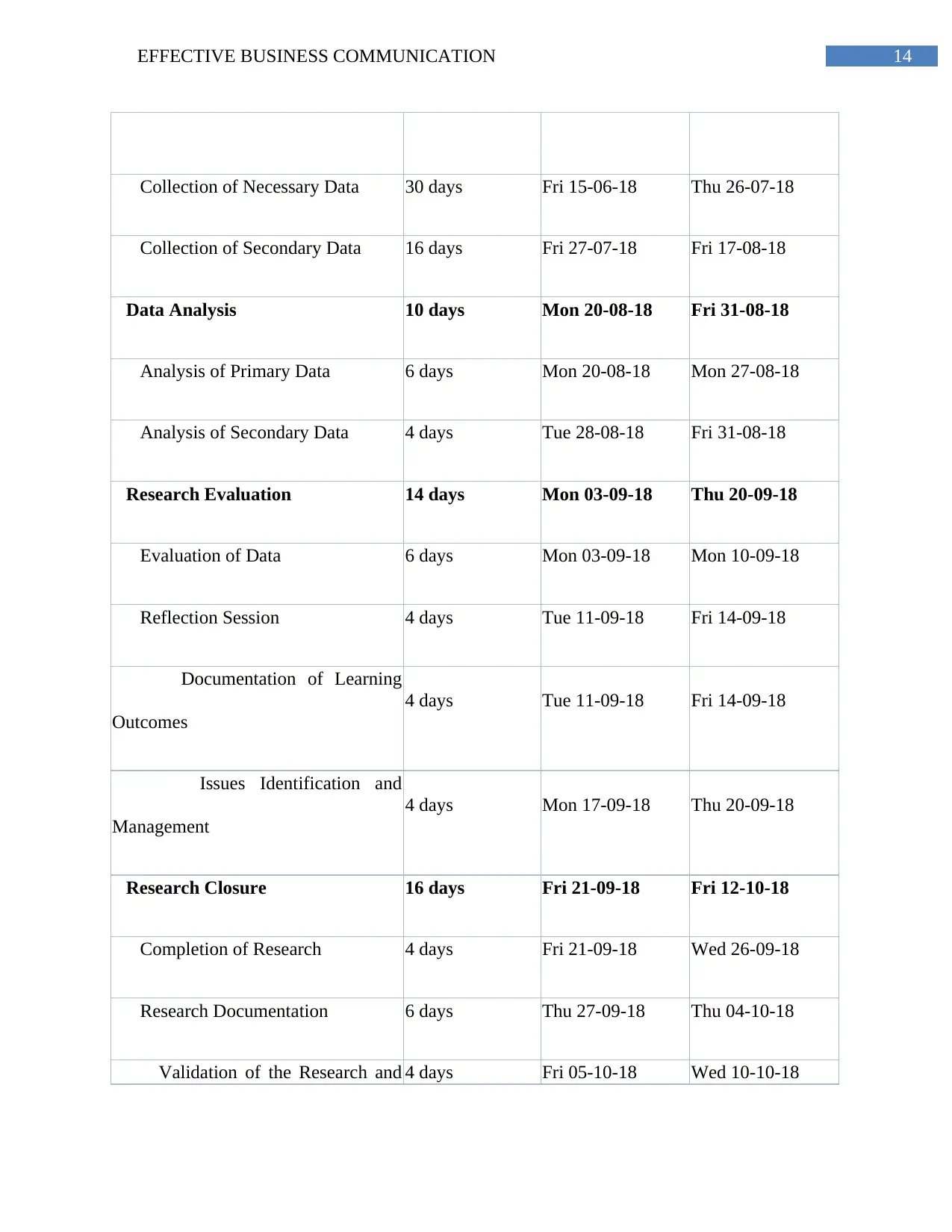
14EFFECTIVE BUSINESS COMMUNICATION
Collection of Necessary Data 30 days Fri 15-06-18 Thu 26-07-18
Collection of Secondary Data 16 days Fri 27-07-18 Fri 17-08-18
Data Analysis 10 days Mon 20-08-18 Fri 31-08-18
Analysis of Primary Data 6 days Mon 20-08-18 Mon 27-08-18
Analysis of Secondary Data 4 days Tue 28-08-18 Fri 31-08-18
Research Evaluation 14 days Mon 03-09-18 Thu 20-09-18
Evaluation of Data 6 days Mon 03-09-18 Mon 10-09-18
Reflection Session 4 days Tue 11-09-18 Fri 14-09-18
Documentation of Learning
Outcomes
4 days Tue 11-09-18 Fri 14-09-18
Issues Identification and
Management
4 days Mon 17-09-18 Thu 20-09-18
Research Closure 16 days Fri 21-09-18 Fri 12-10-18
Completion of Research 4 days Fri 21-09-18 Wed 26-09-18
Research Documentation 6 days Thu 27-09-18 Thu 04-10-18
Validation of the Research and 4 days Fri 05-10-18 Wed 10-10-18
Collection of Necessary Data 30 days Fri 15-06-18 Thu 26-07-18
Collection of Secondary Data 16 days Fri 27-07-18 Fri 17-08-18
Data Analysis 10 days Mon 20-08-18 Fri 31-08-18
Analysis of Primary Data 6 days Mon 20-08-18 Mon 27-08-18
Analysis of Secondary Data 4 days Tue 28-08-18 Fri 31-08-18
Research Evaluation 14 days Mon 03-09-18 Thu 20-09-18
Evaluation of Data 6 days Mon 03-09-18 Mon 10-09-18
Reflection Session 4 days Tue 11-09-18 Fri 14-09-18
Documentation of Learning
Outcomes
4 days Tue 11-09-18 Fri 14-09-18
Issues Identification and
Management
4 days Mon 17-09-18 Thu 20-09-18
Research Closure 16 days Fri 21-09-18 Fri 12-10-18
Completion of Research 4 days Fri 21-09-18 Wed 26-09-18
Research Documentation 6 days Thu 27-09-18 Thu 04-10-18
Validation of the Research and 4 days Fri 05-10-18 Wed 10-10-18
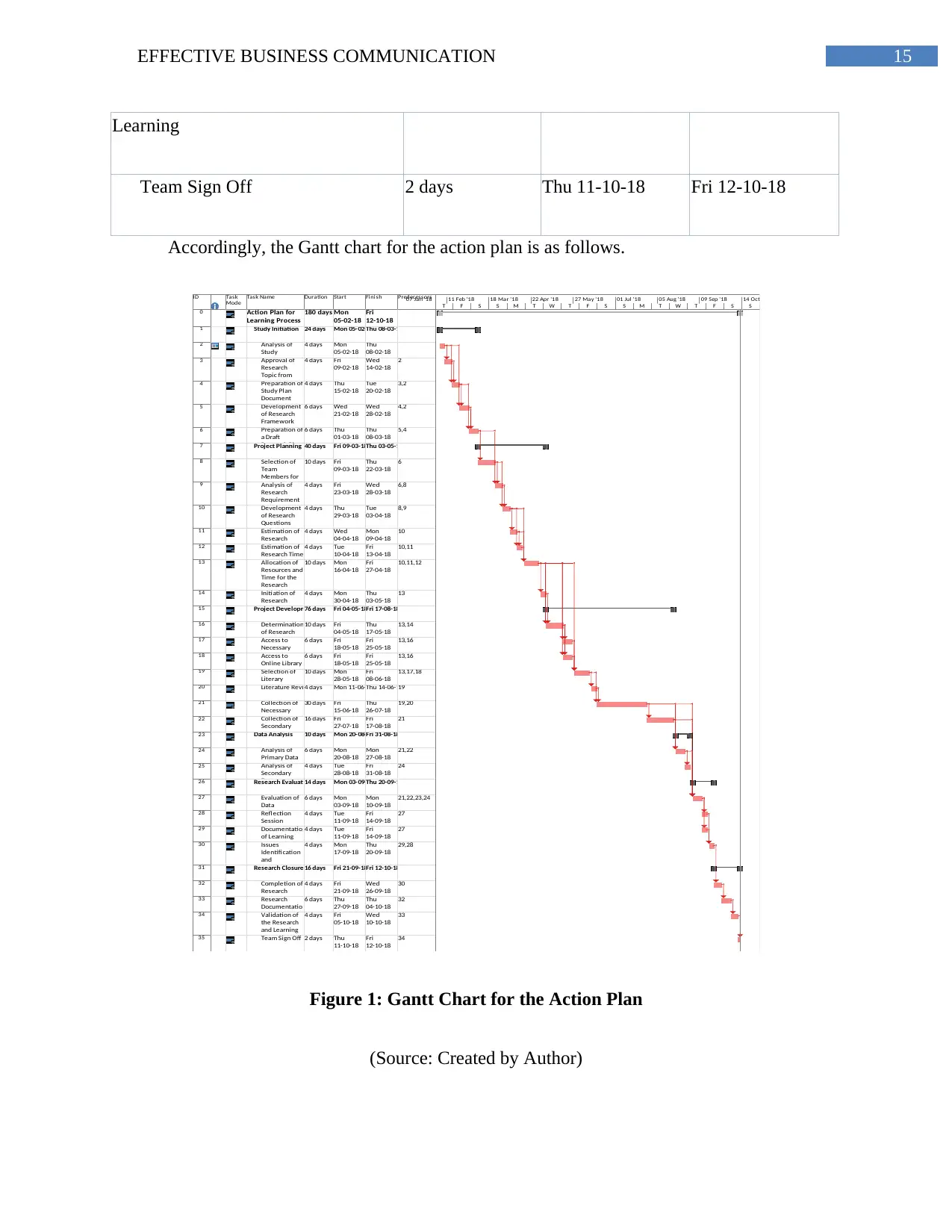
15EFFECTIVE BUSINESS COMMUNICATION
Learning
Team Sign Off 2 days Thu 11-10-18 Fri 12-10-18
Accordingly, the Gantt chart for the action plan is as follows.
ID Task
Mode
Task Name Duration Start Fini sh Predecessors
0 Action Plan for
Learning Process
180 days Mon
05-02-18
Fri
12-10-18
1 Study Initiation 24 days Mon 05-02-18Thu 08-03-18
2 Analysis of
Study
Requirements
4 days Mon
05-02-18
Thu
08-02-18
3 Approval of
Research
Topic from
Supervisor
4 days Fri
09-02-18
Wed
14-02-18
2
4 Preparation of
Study Plan
Document
4 days Thu
15-02-18
Tue
20-02-18
3,2
5 Development
of Research
Framework
6 days Wed
21-02-18
Wed
28-02-18
4,2
6 Preparation of
a Draft
Research Plan
6 days Thu
01-03-18
Thu
08-03-18
5,4
7 Project Planning 40 days Fri 09-03-18Thu 03-05-18
8 Selection of
Team
Members for
the Research
10 days Fri
09-03-18
Thu
22-03-18
6
9 Analysis of
Research
Requirement
4 days Fri
23-03-18
Wed
28-03-18
6,8
10 Development
of Research
Questions
4 days Thu
29-03-18
Tue
03-04-18
8,9
11 Estimation of
Research
Scope
4 days Wed
04-04-18
Mon
09-04-18
10
12 Estimation of
Research Time
4 days Tue
10-04-18
Fri
13-04-18
10,11
13 Allocation of
Resources and
Time for the
Research
10 days Mon
16-04-18
Fri
27-04-18
10,11,12
14 Initiation of
Research
4 days Mon
30-04-18
Thu
03-05-18
13
15 Project Development76 days Fri 04-05-18Fri 17-08-18
16 Determination
of Research
Problems
10 days Fri
04-05-18
Thu
17-05-18
13,14
17 Access to
Necessary
Media
6 days Fri
18-05-18
Fri
25-05-18
13,16
18 Access to
Online Library
6 days Fri
18-05-18
Fri
25-05-18
13,16
19 Selection of
Literary
Sources
10 days Mon
28-05-18
Fri
08-06-18
13,17,18
20 Literature Review4 days Mon 11-06-18Thu 14-06-1819
21 Collection of
Necessary
Data
30 days Fri
15-06-18
Thu
26-07-18
19,20
22 Collection of
Secondary
Data
16 days Fri
27-07-18
Fri
17-08-18
21
23 Data Analysis 10 days Mon 20-08-18Fri 31-08-18
24 Analysis of
Primary Data
6 days Mon
20-08-18
Mon
27-08-18
21,22
25 Analysis of
Secondary
Data
4 days Tue
28-08-18
Fri
31-08-18
24
26 Research Evaluation14 days Mon 03-09-18Thu 20-09-18
27 Evaluation of
Data
6 days Mon
03-09-18
Mon
10-09-18
21,22,23,24
28 Reflection
Session
4 days Tue
11-09-18
Fri
14-09-18
27
29 Documentation
of Learning
Outcomes
4 days Tue
11-09-18
Fri
14-09-18
27
30 Issues
Identification
and
Management
4 days Mon
17-09-18
Thu
20-09-18
29,28
31 Research Closure 16 days Fri 21-09-18Fri 12-10-18
32 Completion of
Research
4 days Fri
21-09-18
Wed
26-09-18
30
33 Research
Documentation
6 days Thu
27-09-18
Thu
04-10-18
32
34 Validation of
the Research
and Learning
4 days Fri
05-10-18
Wed
10-10-18
33
35 Team Sign Off 2 days Thu
11-10-18
Fri
12-10-18
34
T F S S M T W T F S S M T W T F S S M
07 Jan '18 11 Feb '18 18 Mar '18 22 Apr '18 27 May '18 01 Jul '18 05 Aug '18 09 Sep '18 14 Oct '18
Figure 1: Gantt Chart for the Action Plan
(Source: Created by Author)
Learning
Team Sign Off 2 days Thu 11-10-18 Fri 12-10-18
Accordingly, the Gantt chart for the action plan is as follows.
ID Task
Mode
Task Name Duration Start Fini sh Predecessors
0 Action Plan for
Learning Process
180 days Mon
05-02-18
Fri
12-10-18
1 Study Initiation 24 days Mon 05-02-18Thu 08-03-18
2 Analysis of
Study
Requirements
4 days Mon
05-02-18
Thu
08-02-18
3 Approval of
Research
Topic from
Supervisor
4 days Fri
09-02-18
Wed
14-02-18
2
4 Preparation of
Study Plan
Document
4 days Thu
15-02-18
Tue
20-02-18
3,2
5 Development
of Research
Framework
6 days Wed
21-02-18
Wed
28-02-18
4,2
6 Preparation of
a Draft
Research Plan
6 days Thu
01-03-18
Thu
08-03-18
5,4
7 Project Planning 40 days Fri 09-03-18Thu 03-05-18
8 Selection of
Team
Members for
the Research
10 days Fri
09-03-18
Thu
22-03-18
6
9 Analysis of
Research
Requirement
4 days Fri
23-03-18
Wed
28-03-18
6,8
10 Development
of Research
Questions
4 days Thu
29-03-18
Tue
03-04-18
8,9
11 Estimation of
Research
Scope
4 days Wed
04-04-18
Mon
09-04-18
10
12 Estimation of
Research Time
4 days Tue
10-04-18
Fri
13-04-18
10,11
13 Allocation of
Resources and
Time for the
Research
10 days Mon
16-04-18
Fri
27-04-18
10,11,12
14 Initiation of
Research
4 days Mon
30-04-18
Thu
03-05-18
13
15 Project Development76 days Fri 04-05-18Fri 17-08-18
16 Determination
of Research
Problems
10 days Fri
04-05-18
Thu
17-05-18
13,14
17 Access to
Necessary
Media
6 days Fri
18-05-18
Fri
25-05-18
13,16
18 Access to
Online Library
6 days Fri
18-05-18
Fri
25-05-18
13,16
19 Selection of
Literary
Sources
10 days Mon
28-05-18
Fri
08-06-18
13,17,18
20 Literature Review4 days Mon 11-06-18Thu 14-06-1819
21 Collection of
Necessary
Data
30 days Fri
15-06-18
Thu
26-07-18
19,20
22 Collection of
Secondary
Data
16 days Fri
27-07-18
Fri
17-08-18
21
23 Data Analysis 10 days Mon 20-08-18Fri 31-08-18
24 Analysis of
Primary Data
6 days Mon
20-08-18
Mon
27-08-18
21,22
25 Analysis of
Secondary
Data
4 days Tue
28-08-18
Fri
31-08-18
24
26 Research Evaluation14 days Mon 03-09-18Thu 20-09-18
27 Evaluation of
Data
6 days Mon
03-09-18
Mon
10-09-18
21,22,23,24
28 Reflection
Session
4 days Tue
11-09-18
Fri
14-09-18
27
29 Documentation
of Learning
Outcomes
4 days Tue
11-09-18
Fri
14-09-18
27
30 Issues
Identification
and
Management
4 days Mon
17-09-18
Thu
20-09-18
29,28
31 Research Closure 16 days Fri 21-09-18Fri 12-10-18
32 Completion of
Research
4 days Fri
21-09-18
Wed
26-09-18
30
33 Research
Documentation
6 days Thu
27-09-18
Thu
04-10-18
32
34 Validation of
the Research
and Learning
4 days Fri
05-10-18
Wed
10-10-18
33
35 Team Sign Off 2 days Thu
11-10-18
Fri
12-10-18
34
T F S S M T W T F S S M T W T F S S M
07 Jan '18 11 Feb '18 18 Mar '18 22 Apr '18 27 May '18 01 Jul '18 05 Aug '18 09 Sep '18 14 Oct '18
Figure 1: Gantt Chart for the Action Plan
(Source: Created by Author)
Secure Best Marks with AI Grader
Need help grading? Try our AI Grader for instant feedback on your assignments.
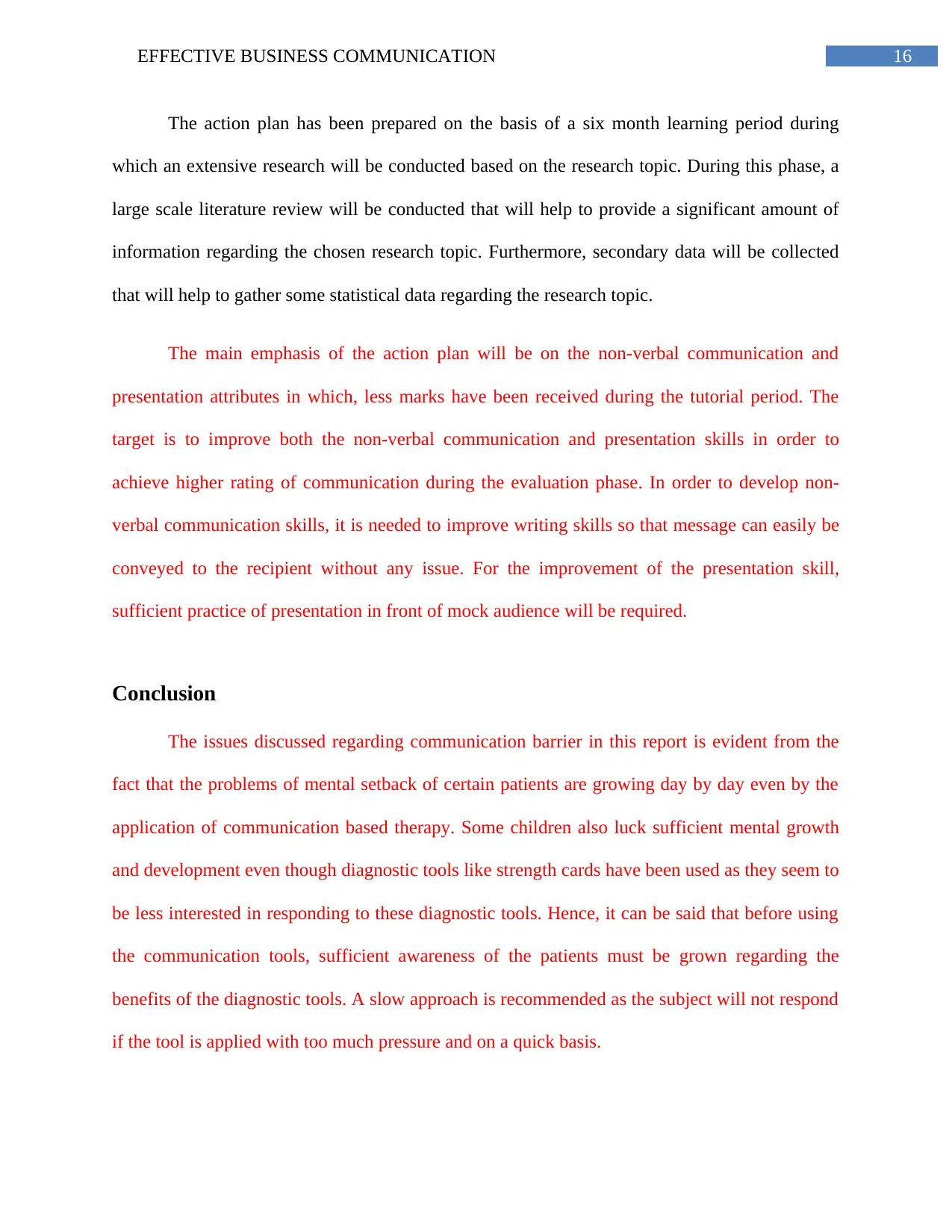
16EFFECTIVE BUSINESS COMMUNICATION
The action plan has been prepared on the basis of a six month learning period during
which an extensive research will be conducted based on the research topic. During this phase, a
large scale literature review will be conducted that will help to provide a significant amount of
information regarding the chosen research topic. Furthermore, secondary data will be collected
that will help to gather some statistical data regarding the research topic.
The main emphasis of the action plan will be on the non-verbal communication and
presentation attributes in which, less marks have been received during the tutorial period. The
target is to improve both the non-verbal communication and presentation skills in order to
achieve higher rating of communication during the evaluation phase. In order to develop non-
verbal communication skills, it is needed to improve writing skills so that message can easily be
conveyed to the recipient without any issue. For the improvement of the presentation skill,
sufficient practice of presentation in front of mock audience will be required.
Conclusion
The issues discussed regarding communication barrier in this report is evident from the
fact that the problems of mental setback of certain patients are growing day by day even by the
application of communication based therapy. Some children also luck sufficient mental growth
and development even though diagnostic tools like strength cards have been used as they seem to
be less interested in responding to these diagnostic tools. Hence, it can be said that before using
the communication tools, sufficient awareness of the patients must be grown regarding the
benefits of the diagnostic tools. A slow approach is recommended as the subject will not respond
if the tool is applied with too much pressure and on a quick basis.
The action plan has been prepared on the basis of a six month learning period during
which an extensive research will be conducted based on the research topic. During this phase, a
large scale literature review will be conducted that will help to provide a significant amount of
information regarding the chosen research topic. Furthermore, secondary data will be collected
that will help to gather some statistical data regarding the research topic.
The main emphasis of the action plan will be on the non-verbal communication and
presentation attributes in which, less marks have been received during the tutorial period. The
target is to improve both the non-verbal communication and presentation skills in order to
achieve higher rating of communication during the evaluation phase. In order to develop non-
verbal communication skills, it is needed to improve writing skills so that message can easily be
conveyed to the recipient without any issue. For the improvement of the presentation skill,
sufficient practice of presentation in front of mock audience will be required.
Conclusion
The issues discussed regarding communication barrier in this report is evident from the
fact that the problems of mental setback of certain patients are growing day by day even by the
application of communication based therapy. Some children also luck sufficient mental growth
and development even though diagnostic tools like strength cards have been used as they seem to
be less interested in responding to these diagnostic tools. Hence, it can be said that before using
the communication tools, sufficient awareness of the patients must be grown regarding the
benefits of the diagnostic tools. A slow approach is recommended as the subject will not respond
if the tool is applied with too much pressure and on a quick basis.
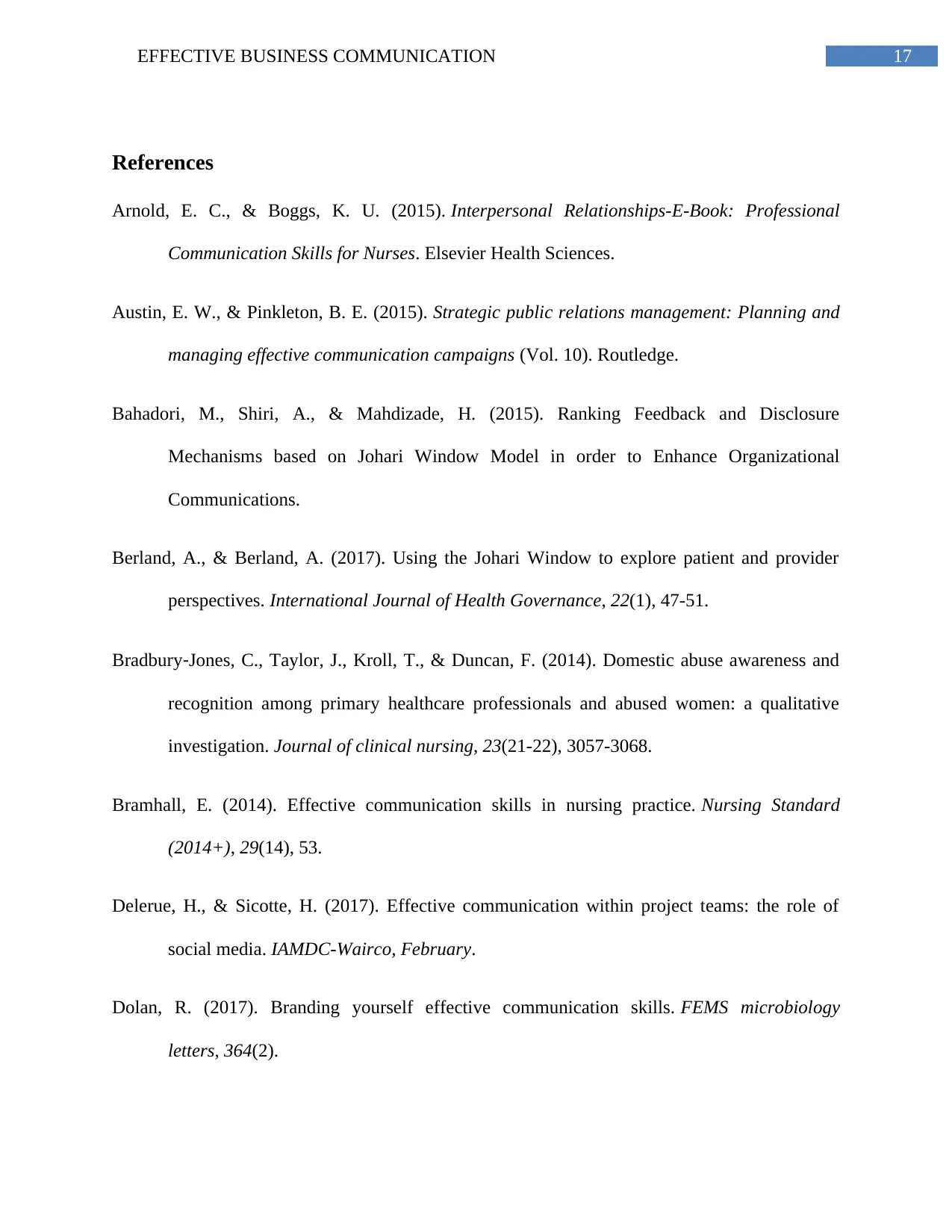
17EFFECTIVE BUSINESS COMMUNICATION
References
Arnold, E. C., & Boggs, K. U. (2015). Interpersonal Relationships-E-Book: Professional
Communication Skills for Nurses. Elsevier Health Sciences.
Austin, E. W., & Pinkleton, B. E. (2015). Strategic public relations management: Planning and
managing effective communication campaigns (Vol. 10). Routledge.
Bahadori, M., Shiri, A., & Mahdizade, H. (2015). Ranking Feedback and Disclosure
Mechanisms based on Johari Window Model in order to Enhance Organizational
Communications.
Berland, A., & Berland, A. (2017). Using the Johari Window to explore patient and provider
perspectives. International Journal of Health Governance, 22(1), 47-51.
Bradbury‐Jones, C., Taylor, J., Kroll, T., & Duncan, F. (2014). Domestic abuse awareness and
recognition among primary healthcare professionals and abused women: a qualitative
investigation. Journal of clinical nursing, 23(21-22), 3057-3068.
Bramhall, E. (2014). Effective communication skills in nursing practice. Nursing Standard
(2014+), 29(14), 53.
Delerue, H., & Sicotte, H. (2017). Effective communication within project teams: the role of
social media. IAMDC-Wairco, February.
Dolan, R. (2017). Branding yourself effective communication skills. FEMS microbiology
letters, 364(2).
References
Arnold, E. C., & Boggs, K. U. (2015). Interpersonal Relationships-E-Book: Professional
Communication Skills for Nurses. Elsevier Health Sciences.
Austin, E. W., & Pinkleton, B. E. (2015). Strategic public relations management: Planning and
managing effective communication campaigns (Vol. 10). Routledge.
Bahadori, M., Shiri, A., & Mahdizade, H. (2015). Ranking Feedback and Disclosure
Mechanisms based on Johari Window Model in order to Enhance Organizational
Communications.
Berland, A., & Berland, A. (2017). Using the Johari Window to explore patient and provider
perspectives. International Journal of Health Governance, 22(1), 47-51.
Bradbury‐Jones, C., Taylor, J., Kroll, T., & Duncan, F. (2014). Domestic abuse awareness and
recognition among primary healthcare professionals and abused women: a qualitative
investigation. Journal of clinical nursing, 23(21-22), 3057-3068.
Bramhall, E. (2014). Effective communication skills in nursing practice. Nursing Standard
(2014+), 29(14), 53.
Delerue, H., & Sicotte, H. (2017). Effective communication within project teams: the role of
social media. IAMDC-Wairco, February.
Dolan, R. (2017). Branding yourself effective communication skills. FEMS microbiology
letters, 364(2).

18EFFECTIVE BUSINESS COMMUNICATION
Drake, M. L., & Ring, D. C. (2016). Enthesopathy of the extensor carpi radialis brevis origin:
effective communication strategies. JAAOS-Journal of the American Academy of
Orthopaedic Surgeons, 24(6), 365-369.
Fan, S. P., Liberman, Z., Keysar, B., & Kinzler, K. D. (2015). The exposure advantage: Early
exposure to a multilingual environment promotes effective
communication. Psychological Science, 26(7), 1090-1097.
Ghaferi, A. A., & Dimick, J. B. (2015). Understanding failure to rescue and improving safety
culture. Annals of surgery, 261(5), 839.
Greenaway, K. H., Wright, R. G., Willingham, J., Reynolds, K. J., & Haslam, S. A. (2015).
Shared identity is key to effective communication. Personality and Social Psychology
Bulletin, 41(2), 171-182.
Heinrich, A., Gagne, J. P., Viljanen, A., Levy, D. A., Ben-David, B., & Schneider, B. A. (2016).
Effective communication as a fundamental aspect of active aging and well-being: paying
attention to the challenges older adults face in noisy environments. Social Inquiry into
Well-Being, 2(1), 51-69.
Hobart-Porter, L., Wade, S., Minich, N., Kirkwood, M., Stancin, T., & Taylor, H. G. (2015).
Determinants of effective caregiver communication after adolescent traumatic brain
injury. PM&R, 7(8), 836-844.
King, G., Desmarais, C., Lindsay, S., Piérart, G., & Tétreault, S. (2015). The roles of effective
communication and client engagement in delivering culturally sensitive care to immigrant
parents of children with disabilities. Disability and rehabilitation, 37(15), 1372-1381.
Drake, M. L., & Ring, D. C. (2016). Enthesopathy of the extensor carpi radialis brevis origin:
effective communication strategies. JAAOS-Journal of the American Academy of
Orthopaedic Surgeons, 24(6), 365-369.
Fan, S. P., Liberman, Z., Keysar, B., & Kinzler, K. D. (2015). The exposure advantage: Early
exposure to a multilingual environment promotes effective
communication. Psychological Science, 26(7), 1090-1097.
Ghaferi, A. A., & Dimick, J. B. (2015). Understanding failure to rescue and improving safety
culture. Annals of surgery, 261(5), 839.
Greenaway, K. H., Wright, R. G., Willingham, J., Reynolds, K. J., & Haslam, S. A. (2015).
Shared identity is key to effective communication. Personality and Social Psychology
Bulletin, 41(2), 171-182.
Heinrich, A., Gagne, J. P., Viljanen, A., Levy, D. A., Ben-David, B., & Schneider, B. A. (2016).
Effective communication as a fundamental aspect of active aging and well-being: paying
attention to the challenges older adults face in noisy environments. Social Inquiry into
Well-Being, 2(1), 51-69.
Hobart-Porter, L., Wade, S., Minich, N., Kirkwood, M., Stancin, T., & Taylor, H. G. (2015).
Determinants of effective caregiver communication after adolescent traumatic brain
injury. PM&R, 7(8), 836-844.
King, G., Desmarais, C., Lindsay, S., Piérart, G., & Tétreault, S. (2015). The roles of effective
communication and client engagement in delivering culturally sensitive care to immigrant
parents of children with disabilities. Disability and rehabilitation, 37(15), 1372-1381.
Paraphrase This Document
Need a fresh take? Get an instant paraphrase of this document with our AI Paraphraser

19EFFECTIVE BUSINESS COMMUNICATION
McCabe, C., & Timmins, F. (2013). Communication skills for nursing practice. Palgrave
Macmillan.
Meuter, R. F., Gallois, C., Segalowitz, N. S., Ryder, A. G., & Hocking, J. (2015). Overcoming
language barriers in healthcare: A protocol for investigating safe and effective
communication when patients or clinicians use a second language. BMC health services
research, 15(1), 371.
O'hagan, S., Manias, E., Elder, C., Pill, J., Woodward‐Kron, R., McNamara, T., ... & McColl, G.
(2014). What counts as effective communication in nursing? Evidence from nurse
educators' and clinicians' feedback on nurse interactions with simulated patients. Journal
of advanced nursing, 70(6), 1344-1355.
Price, A. M., Stephens, M., Patterson, C., Snelgrove-Clarke, E., Work, F., & Chiang, V. (2015).
What are the patterns of personal learning environments (PLE) for undergraduate
students undertaking degrees in nursing.
Reese, J. B., Beach, M. C., Smith, K. C., Bantug, E. T., Casale, K. E., Porter, L. S., ... & Lepore,
S. J. (2017). Effective patient-provider communication about sexual concerns in breast
cancer: a qualitative study. Supportive Care in Cancer, 25(10), 3199-3207.
Saxena, P. (2015). JOHARI WINDOW: An Effective Model for Improving Interpersonal
Communication and Managerial Effectiveness. SIT Journal of Management, 5(2), 134-
146.
Shockley-Zalabak, P. (2014). Fundamentals of organizational communication. Pearson.
McCabe, C., & Timmins, F. (2013). Communication skills for nursing practice. Palgrave
Macmillan.
Meuter, R. F., Gallois, C., Segalowitz, N. S., Ryder, A. G., & Hocking, J. (2015). Overcoming
language barriers in healthcare: A protocol for investigating safe and effective
communication when patients or clinicians use a second language. BMC health services
research, 15(1), 371.
O'hagan, S., Manias, E., Elder, C., Pill, J., Woodward‐Kron, R., McNamara, T., ... & McColl, G.
(2014). What counts as effective communication in nursing? Evidence from nurse
educators' and clinicians' feedback on nurse interactions with simulated patients. Journal
of advanced nursing, 70(6), 1344-1355.
Price, A. M., Stephens, M., Patterson, C., Snelgrove-Clarke, E., Work, F., & Chiang, V. (2015).
What are the patterns of personal learning environments (PLE) for undergraduate
students undertaking degrees in nursing.
Reese, J. B., Beach, M. C., Smith, K. C., Bantug, E. T., Casale, K. E., Porter, L. S., ... & Lepore,
S. J. (2017). Effective patient-provider communication about sexual concerns in breast
cancer: a qualitative study. Supportive Care in Cancer, 25(10), 3199-3207.
Saxena, P. (2015). JOHARI WINDOW: An Effective Model for Improving Interpersonal
Communication and Managerial Effectiveness. SIT Journal of Management, 5(2), 134-
146.
Shockley-Zalabak, P. (2014). Fundamentals of organizational communication. Pearson.
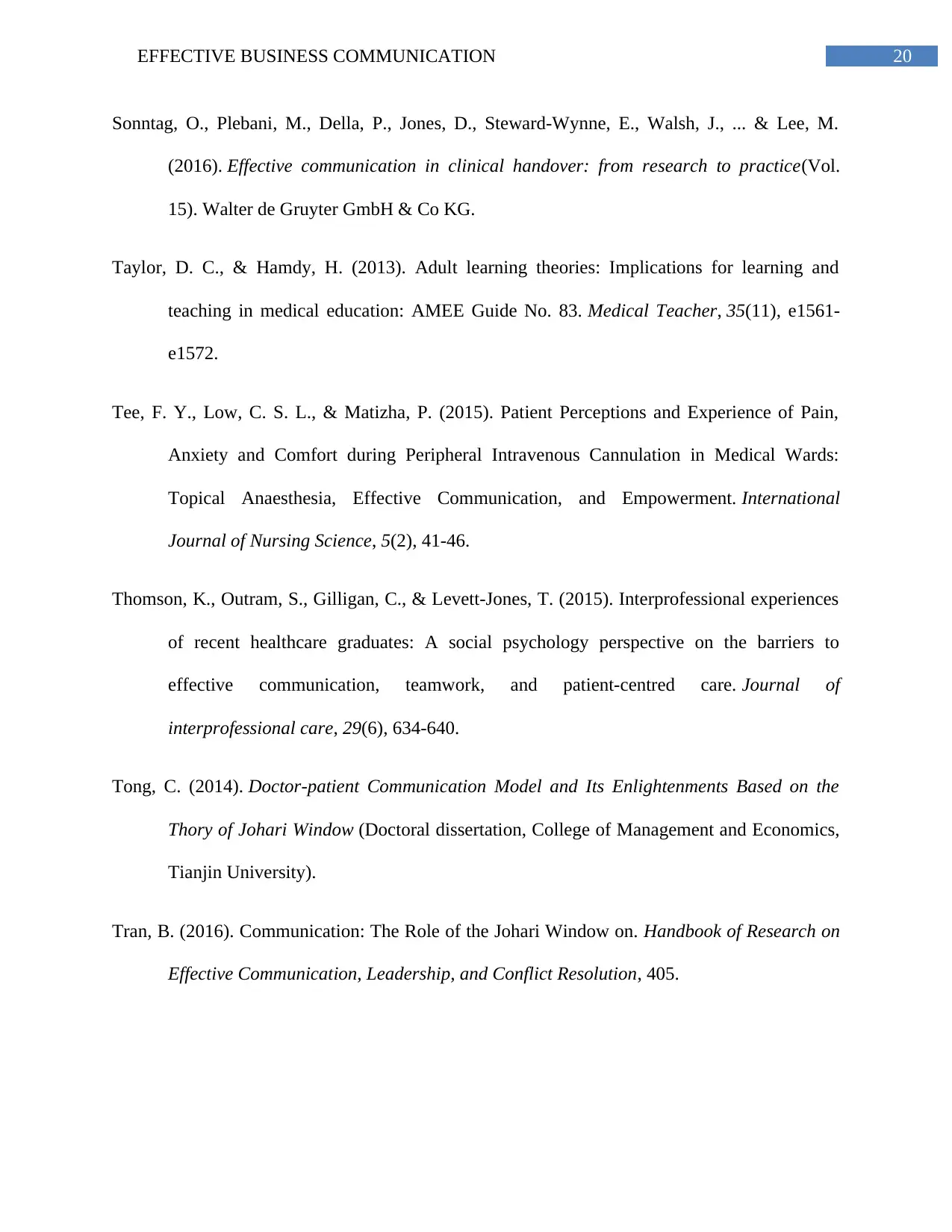
20EFFECTIVE BUSINESS COMMUNICATION
Sonntag, O., Plebani, M., Della, P., Jones, D., Steward-Wynne, E., Walsh, J., ... & Lee, M.
(2016). Effective communication in clinical handover: from research to practice(Vol.
15). Walter de Gruyter GmbH & Co KG.
Taylor, D. C., & Hamdy, H. (2013). Adult learning theories: Implications for learning and
teaching in medical education: AMEE Guide No. 83. Medical Teacher, 35(11), e1561-
e1572.
Tee, F. Y., Low, C. S. L., & Matizha, P. (2015). Patient Perceptions and Experience of Pain,
Anxiety and Comfort during Peripheral Intravenous Cannulation in Medical Wards:
Topical Anaesthesia, Effective Communication, and Empowerment. International
Journal of Nursing Science, 5(2), 41-46.
Thomson, K., Outram, S., Gilligan, C., & Levett-Jones, T. (2015). Interprofessional experiences
of recent healthcare graduates: A social psychology perspective on the barriers to
effective communication, teamwork, and patient-centred care. Journal of
interprofessional care, 29(6), 634-640.
Tong, C. (2014). Doctor-patient Communication Model and Its Enlightenments Based on the
Thory of Johari Window (Doctoral dissertation, College of Management and Economics,
Tianjin University).
Tran, B. (2016). Communication: The Role of the Johari Window on. Handbook of Research on
Effective Communication, Leadership, and Conflict Resolution, 405.
Sonntag, O., Plebani, M., Della, P., Jones, D., Steward-Wynne, E., Walsh, J., ... & Lee, M.
(2016). Effective communication in clinical handover: from research to practice(Vol.
15). Walter de Gruyter GmbH & Co KG.
Taylor, D. C., & Hamdy, H. (2013). Adult learning theories: Implications for learning and
teaching in medical education: AMEE Guide No. 83. Medical Teacher, 35(11), e1561-
e1572.
Tee, F. Y., Low, C. S. L., & Matizha, P. (2015). Patient Perceptions and Experience of Pain,
Anxiety and Comfort during Peripheral Intravenous Cannulation in Medical Wards:
Topical Anaesthesia, Effective Communication, and Empowerment. International
Journal of Nursing Science, 5(2), 41-46.
Thomson, K., Outram, S., Gilligan, C., & Levett-Jones, T. (2015). Interprofessional experiences
of recent healthcare graduates: A social psychology perspective on the barriers to
effective communication, teamwork, and patient-centred care. Journal of
interprofessional care, 29(6), 634-640.
Tong, C. (2014). Doctor-patient Communication Model and Its Enlightenments Based on the
Thory of Johari Window (Doctoral dissertation, College of Management and Economics,
Tianjin University).
Tran, B. (2016). Communication: The Role of the Johari Window on. Handbook of Research on
Effective Communication, Leadership, and Conflict Resolution, 405.
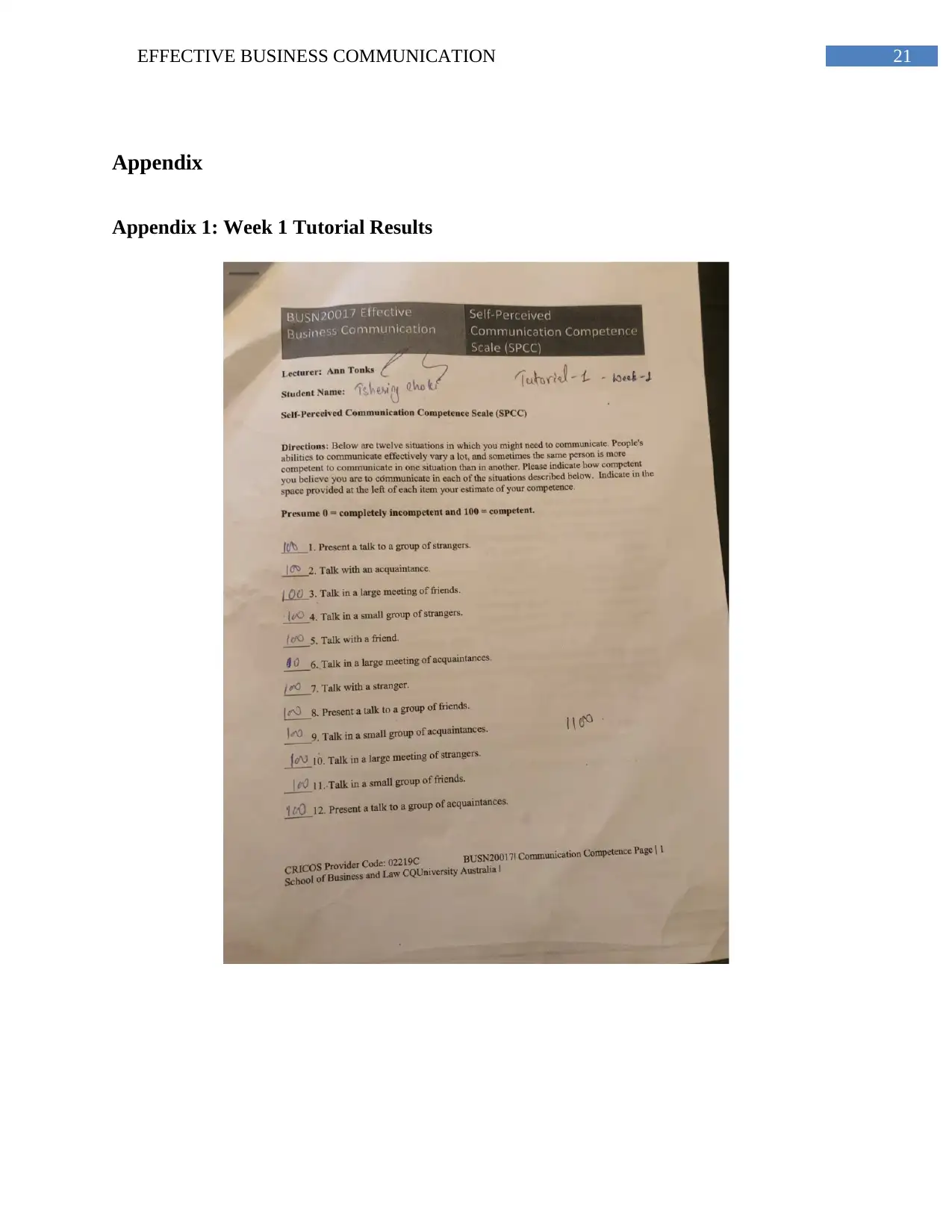
21EFFECTIVE BUSINESS COMMUNICATION
Appendix
Appendix 1: Week 1 Tutorial Results
Appendix
Appendix 1: Week 1 Tutorial Results
Secure Best Marks with AI Grader
Need help grading? Try our AI Grader for instant feedback on your assignments.
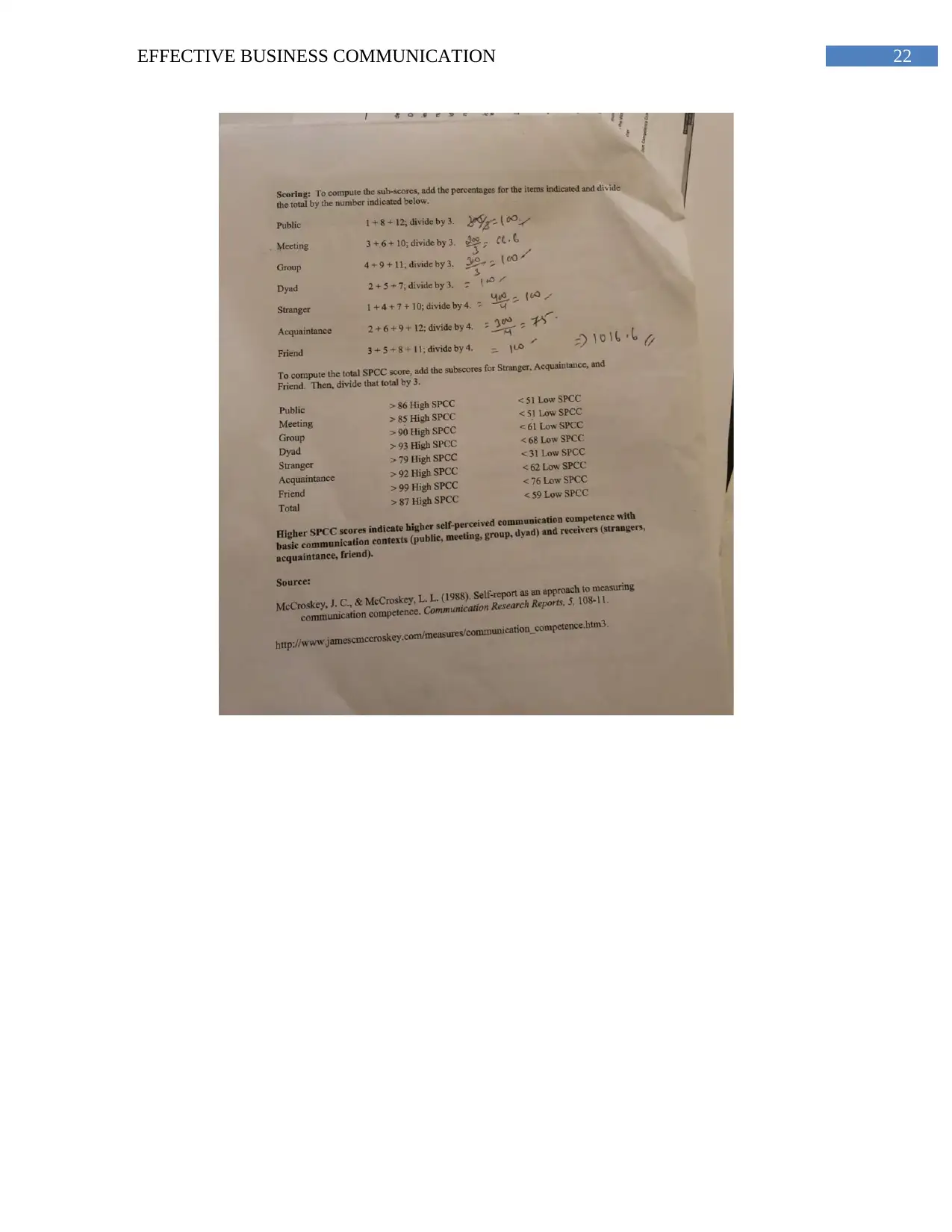
22EFFECTIVE BUSINESS COMMUNICATION
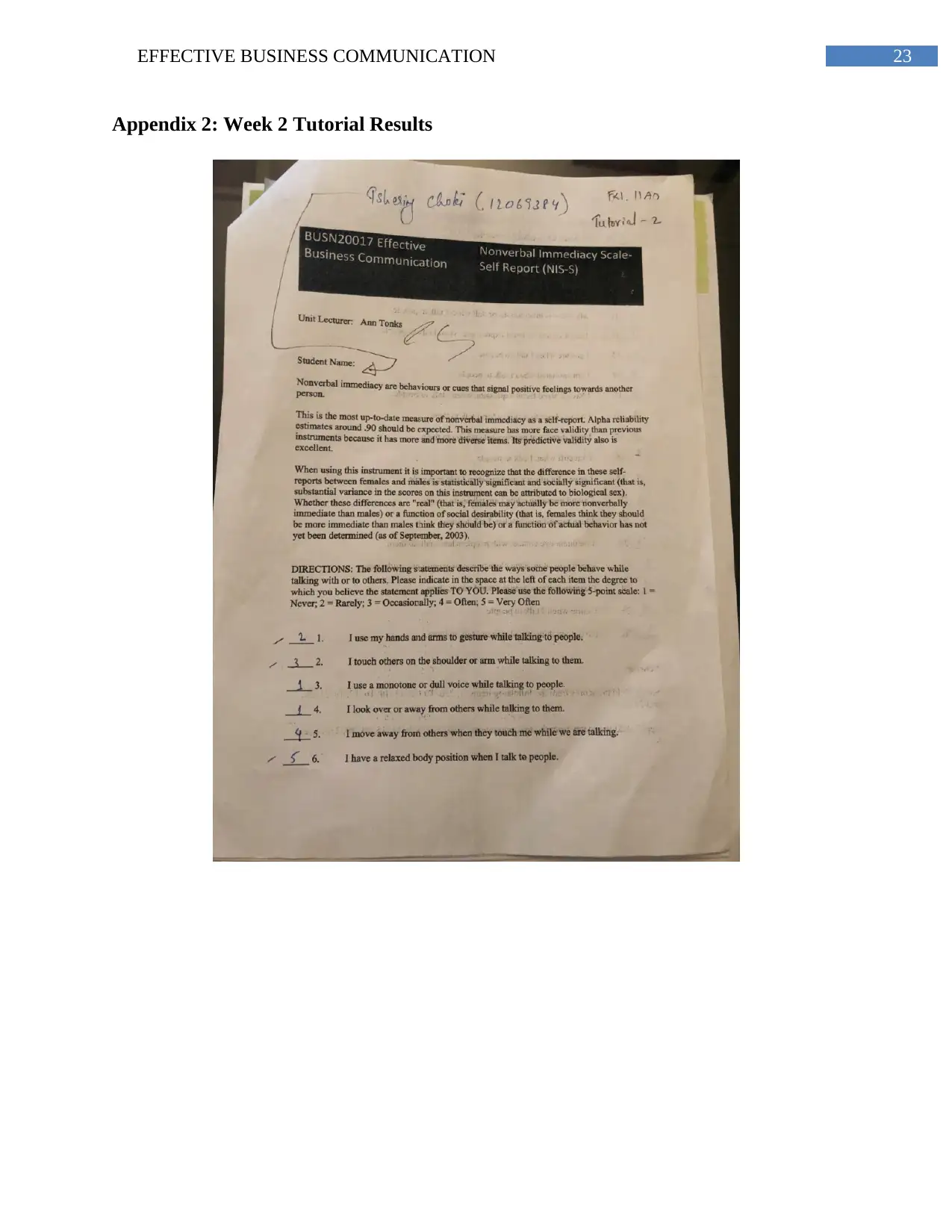
23EFFECTIVE BUSINESS COMMUNICATION
Appendix 2: Week 2 Tutorial Results
Appendix 2: Week 2 Tutorial Results
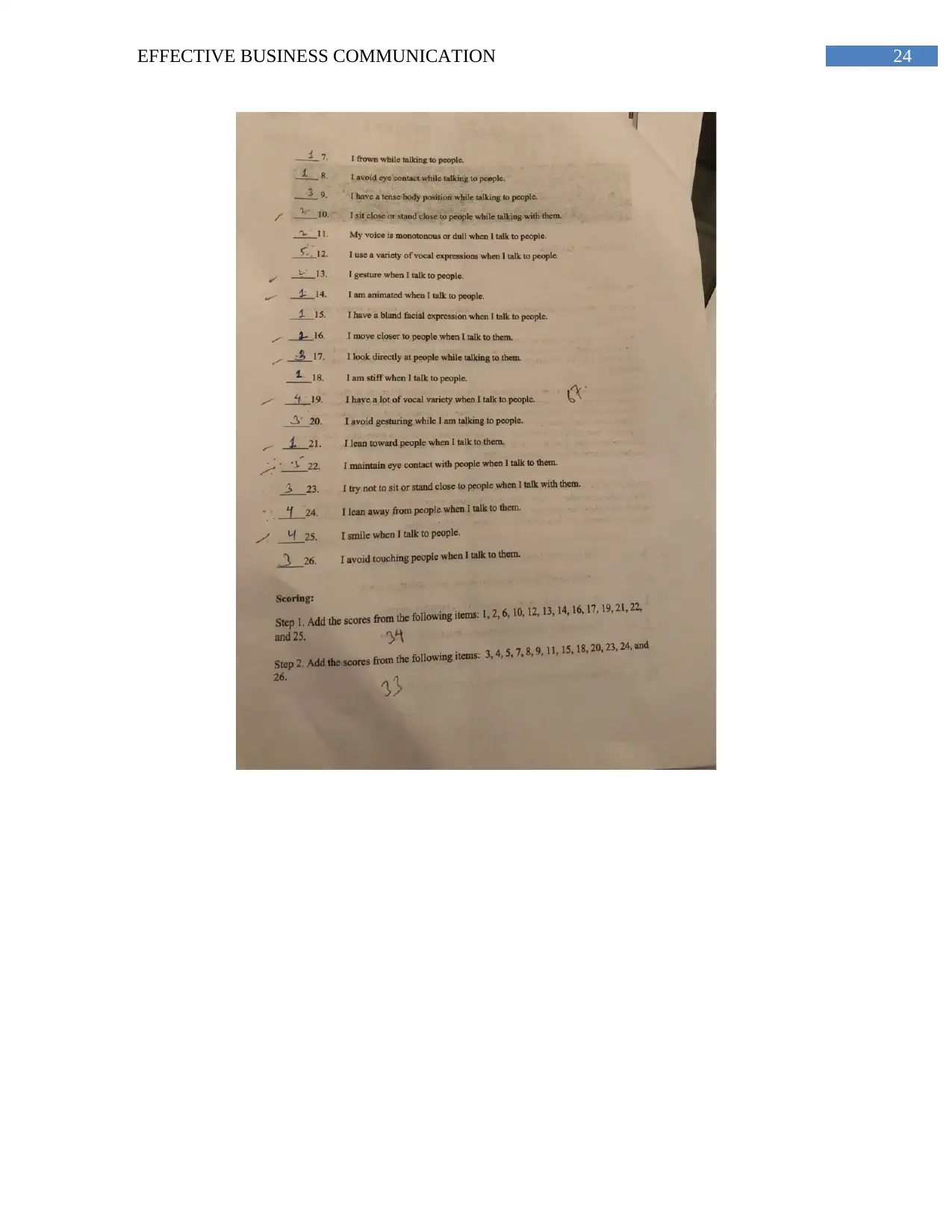
24EFFECTIVE BUSINESS COMMUNICATION
Paraphrase This Document
Need a fresh take? Get an instant paraphrase of this document with our AI Paraphraser
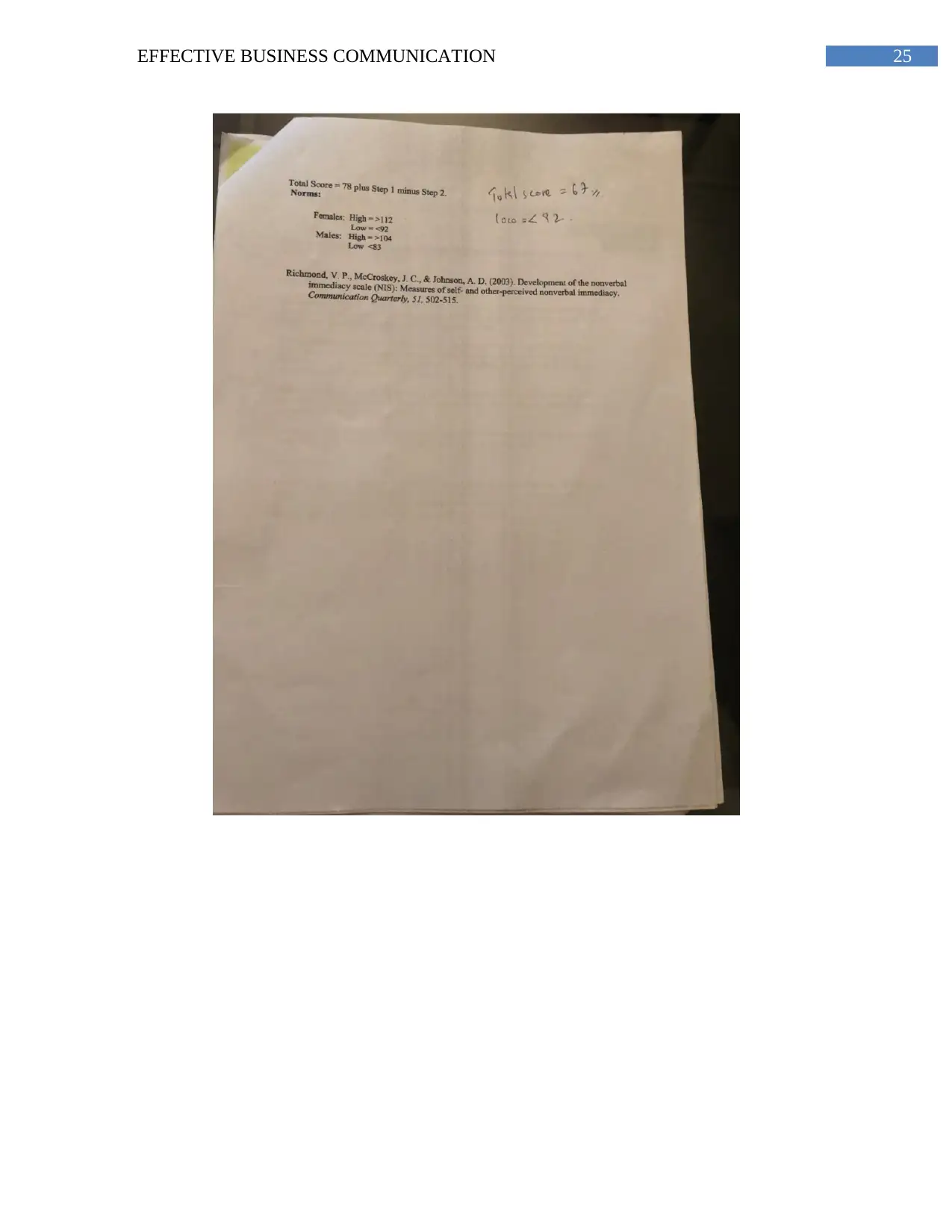
25EFFECTIVE BUSINESS COMMUNICATION
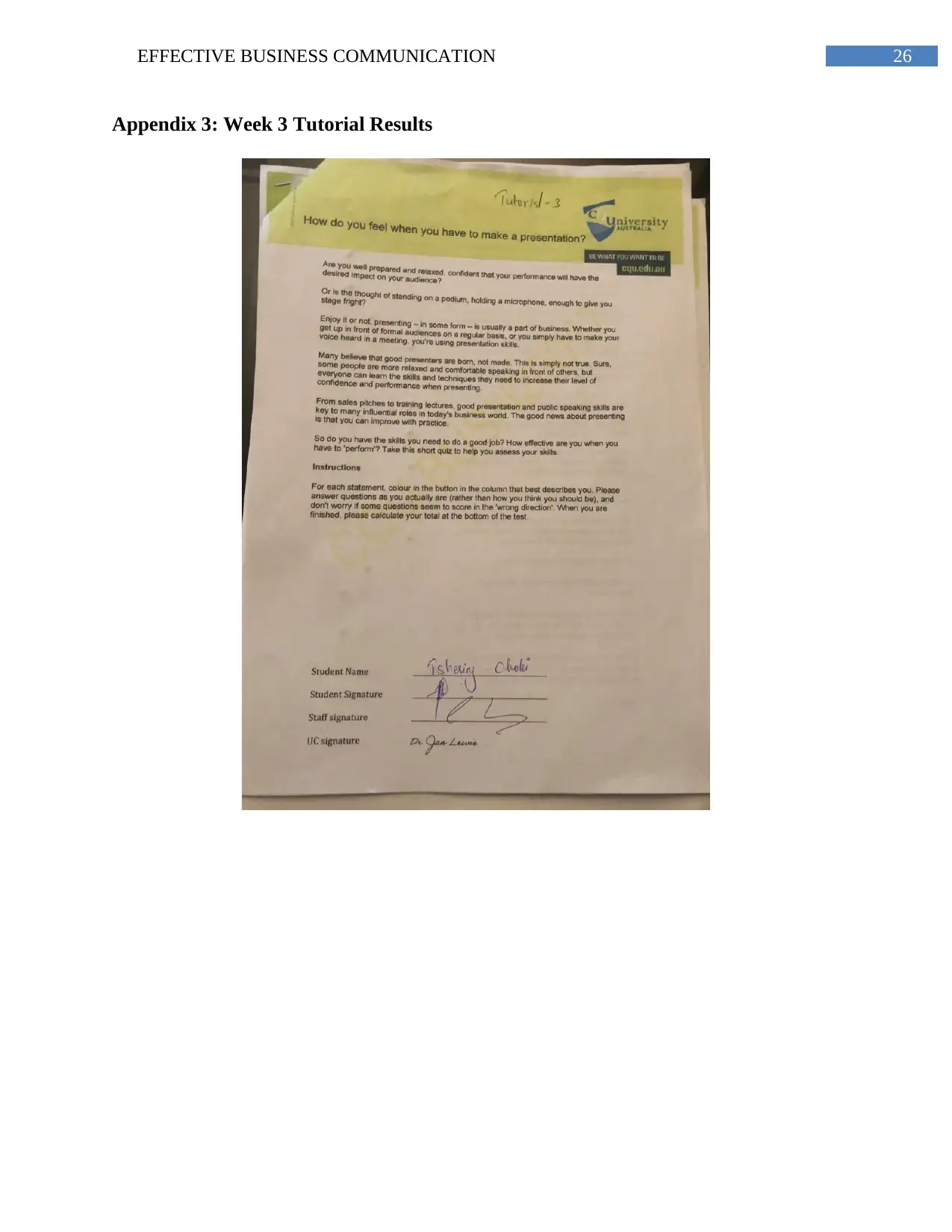
26EFFECTIVE BUSINESS COMMUNICATION
Appendix 3: Week 3 Tutorial Results
Appendix 3: Week 3 Tutorial Results
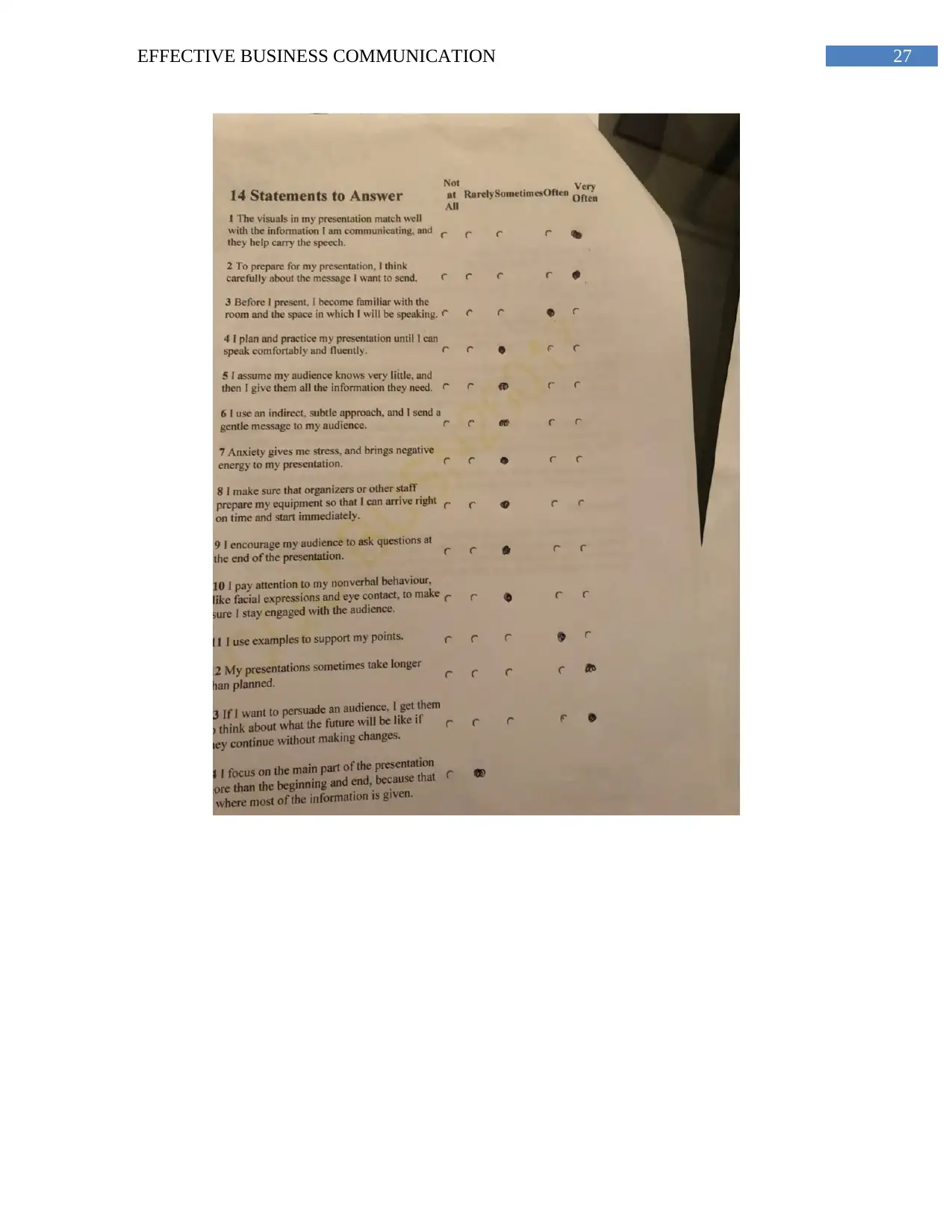
27EFFECTIVE BUSINESS COMMUNICATION
Secure Best Marks with AI Grader
Need help grading? Try our AI Grader for instant feedback on your assignments.
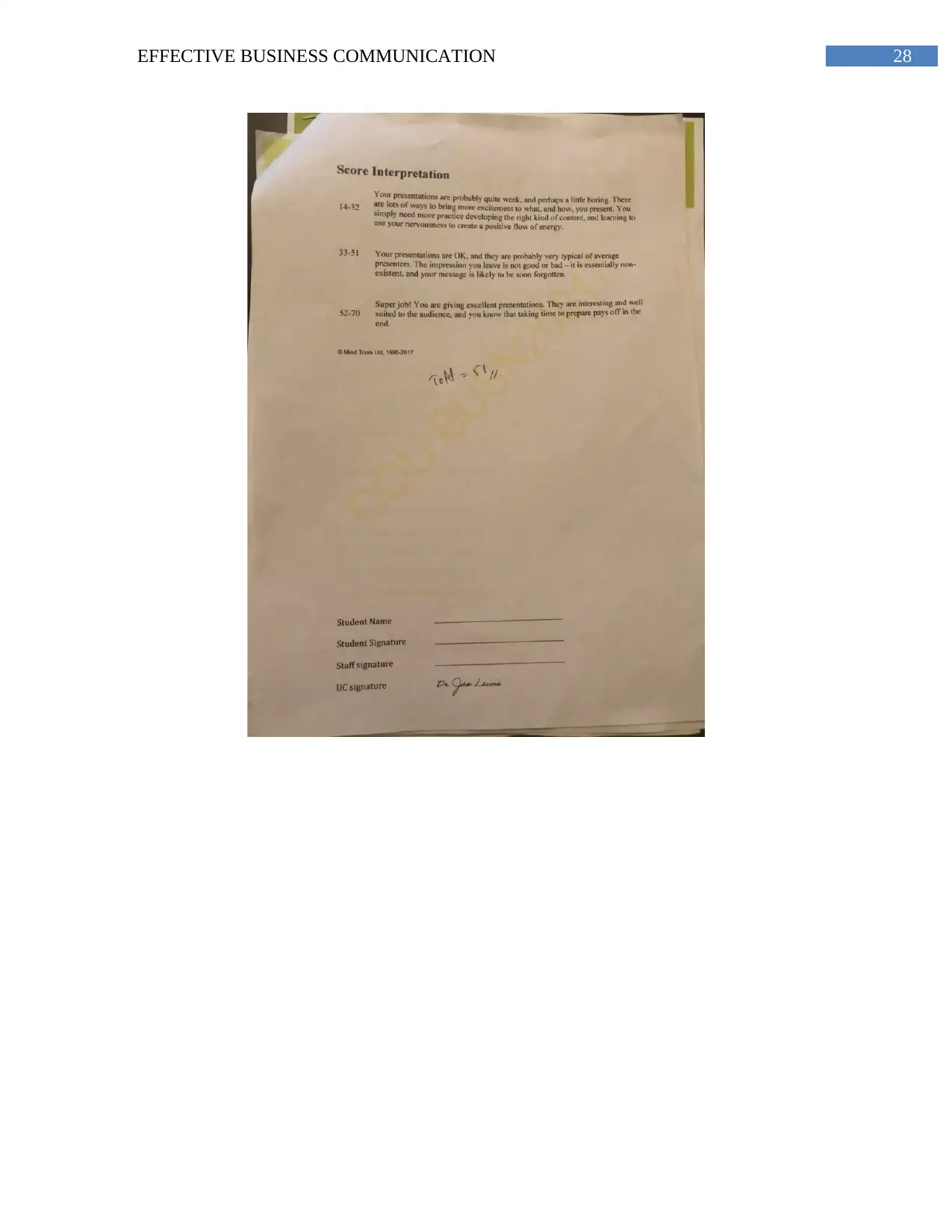
28EFFECTIVE BUSINESS COMMUNICATION
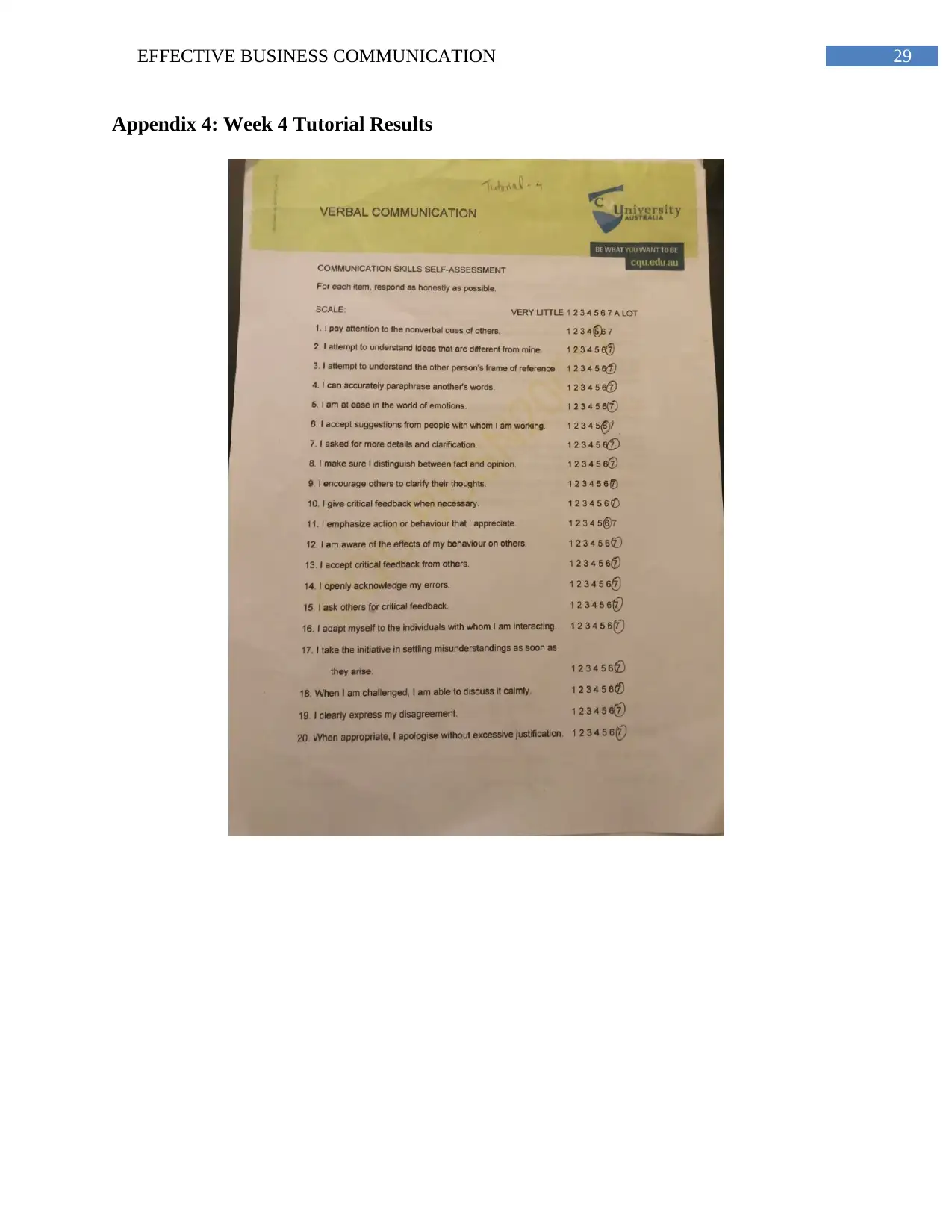
29EFFECTIVE BUSINESS COMMUNICATION
Appendix 4: Week 4 Tutorial Results
Appendix 4: Week 4 Tutorial Results
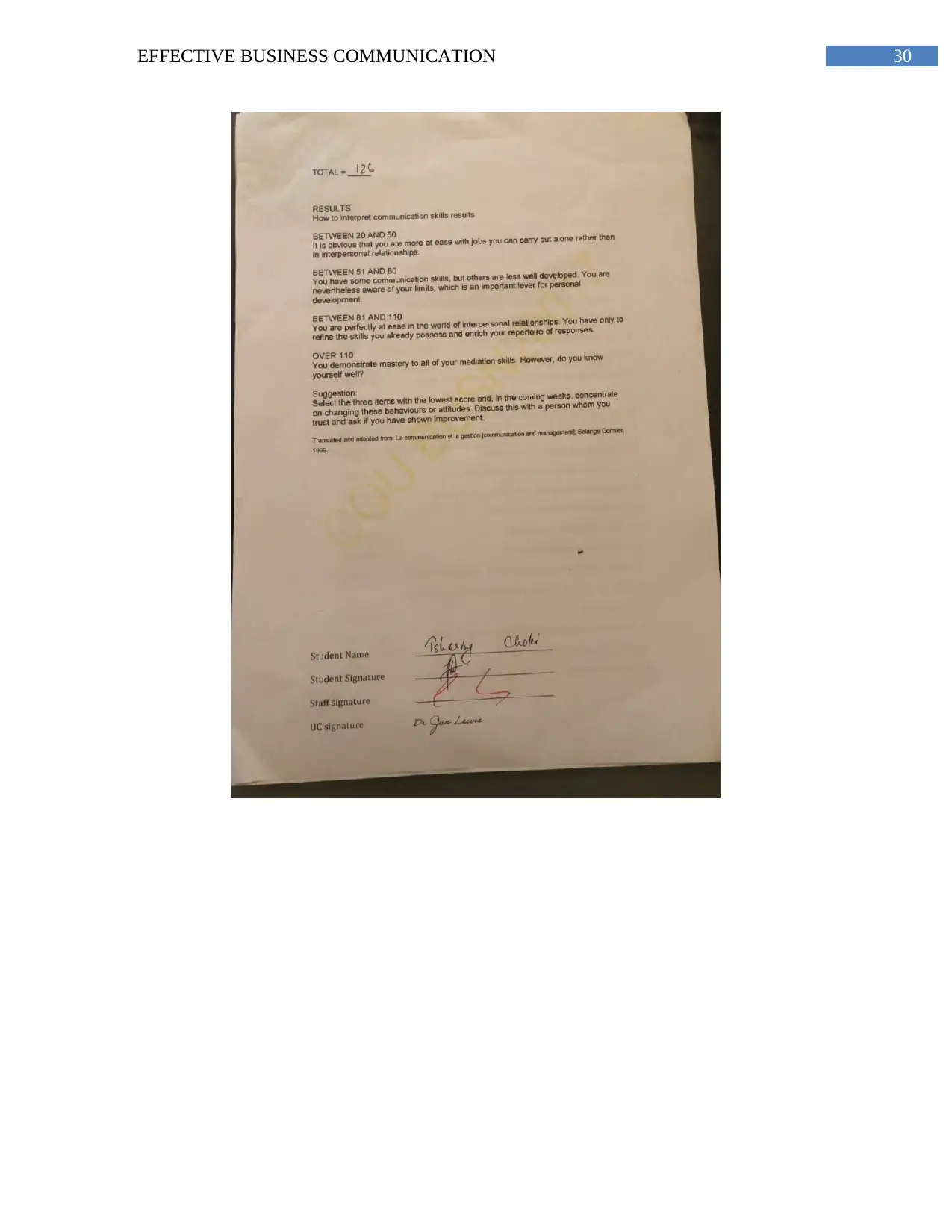
30EFFECTIVE BUSINESS COMMUNICATION
Paraphrase This Document
Need a fresh take? Get an instant paraphrase of this document with our AI Paraphraser
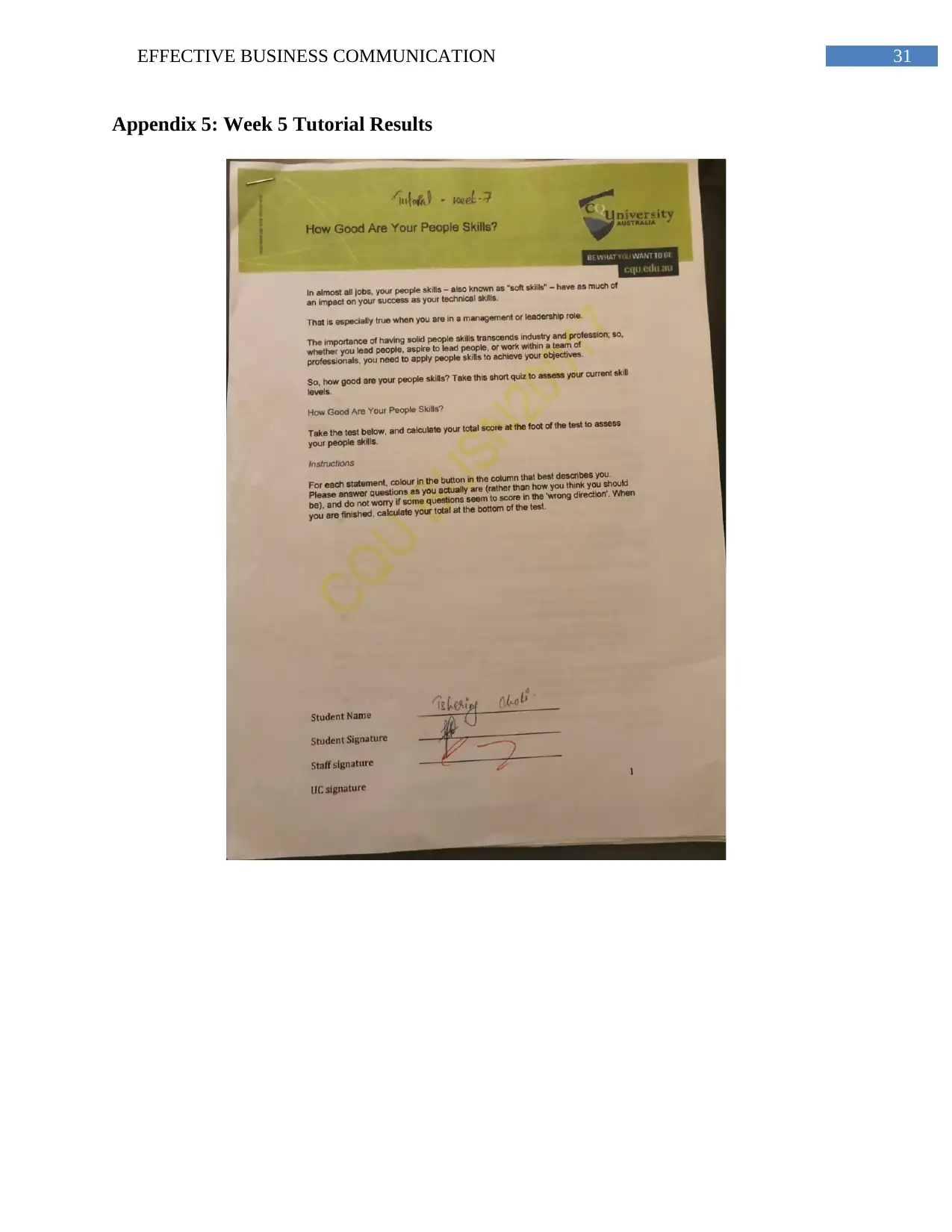
31EFFECTIVE BUSINESS COMMUNICATION
Appendix 5: Week 5 Tutorial Results
Appendix 5: Week 5 Tutorial Results
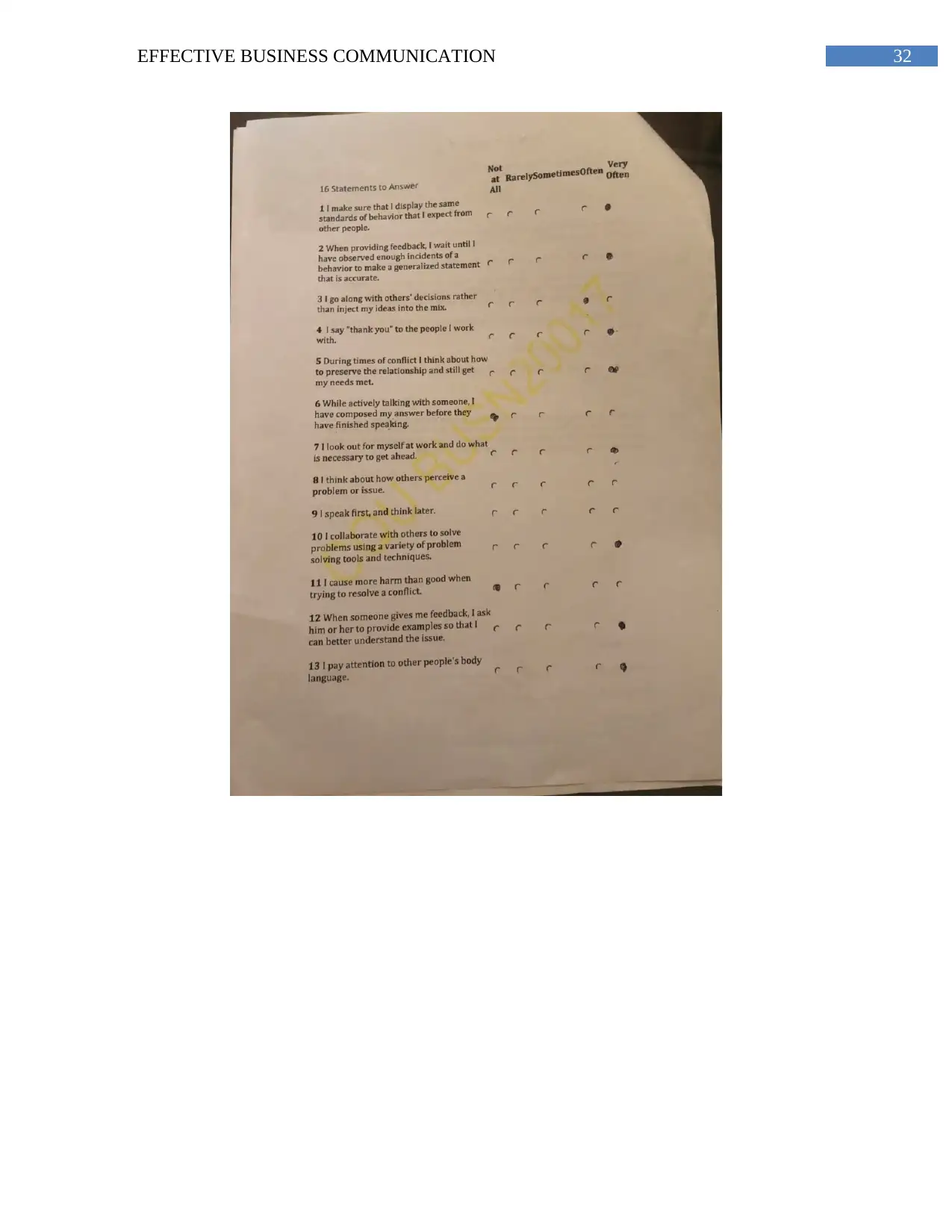
32EFFECTIVE BUSINESS COMMUNICATION
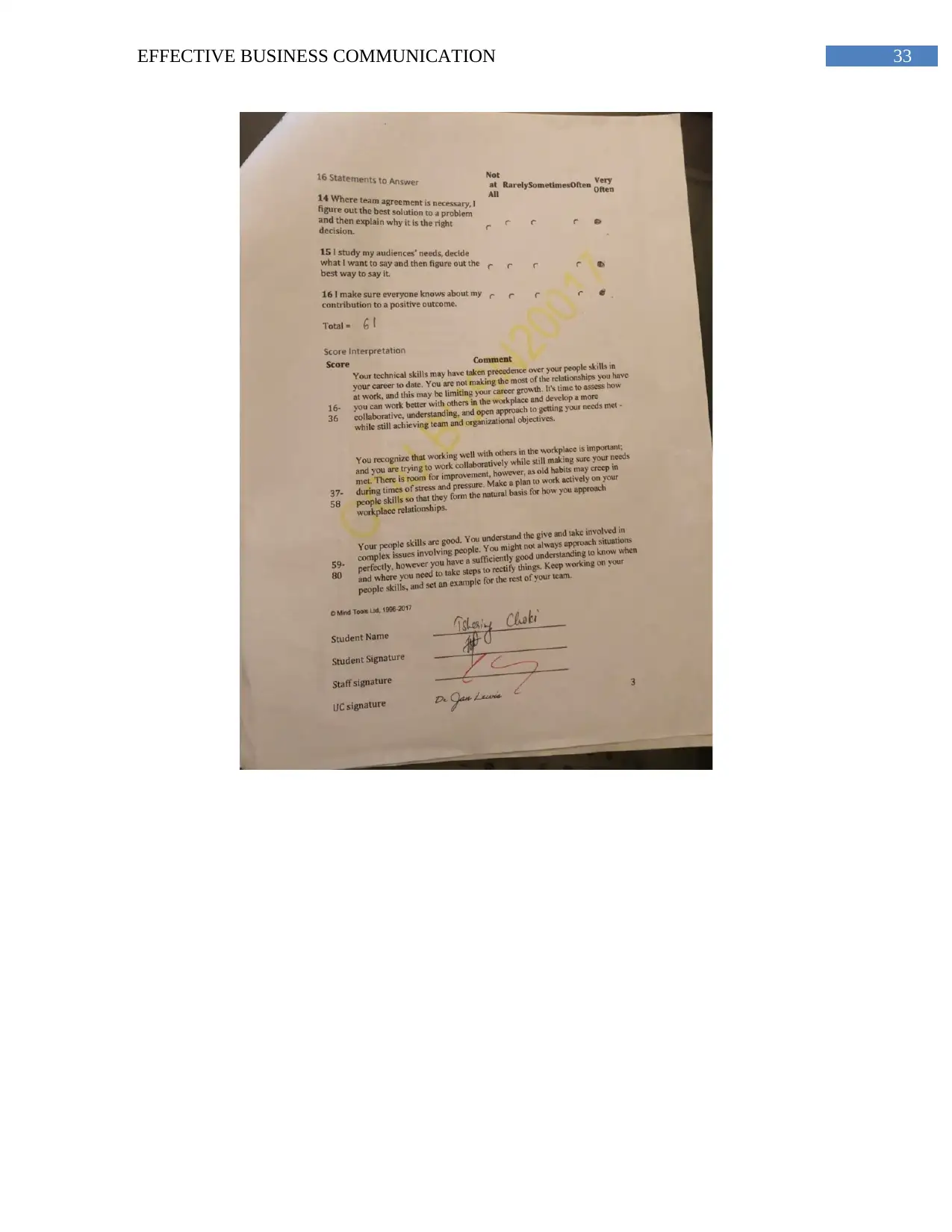
33EFFECTIVE BUSINESS COMMUNICATION
Secure Best Marks with AI Grader
Need help grading? Try our AI Grader for instant feedback on your assignments.
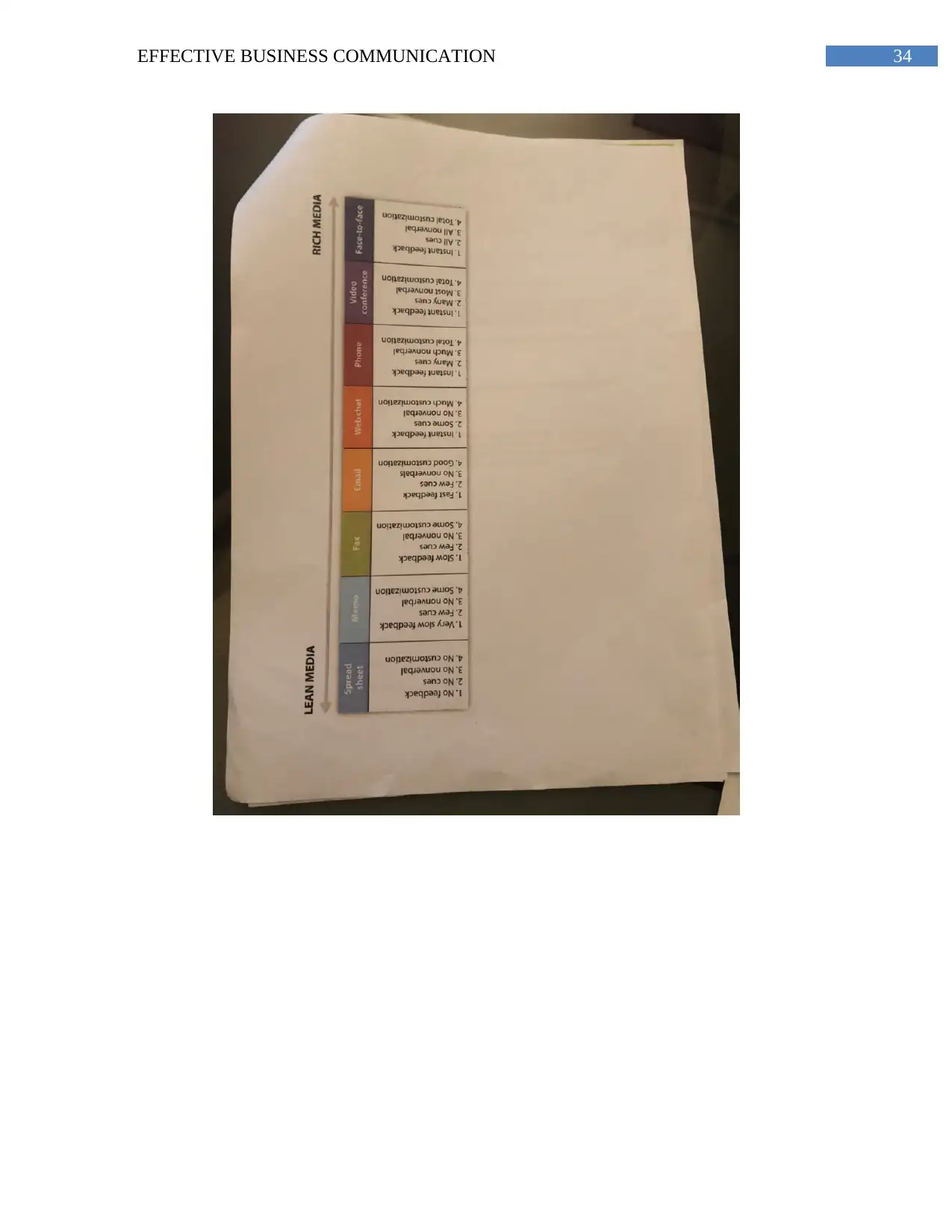
34EFFECTIVE BUSINESS COMMUNICATION
1 out of 35
Related Documents
Your All-in-One AI-Powered Toolkit for Academic Success.
+13062052269
info@desklib.com
Available 24*7 on WhatsApp / Email
![[object Object]](/_next/static/media/star-bottom.7253800d.svg)
Unlock your academic potential
© 2024 | Zucol Services PVT LTD | All rights reserved.





